Silicone wound dressing laminate and method for making the same
Addison , et al. Feb
U.S. patent number 10,568,767 [Application Number 13/982,650] was granted by the patent office on 2020-02-25 for silicone wound dressing laminate and method for making the same. This patent grant is currently assigned to KCI USA, INC.. The grantee listed for this patent is Deborah Addison, Patrick Joseph Brosnan, Sally Stephens. Invention is credited to Deborah Addison, Patrick Joseph Brosnan, Sally Stephens.
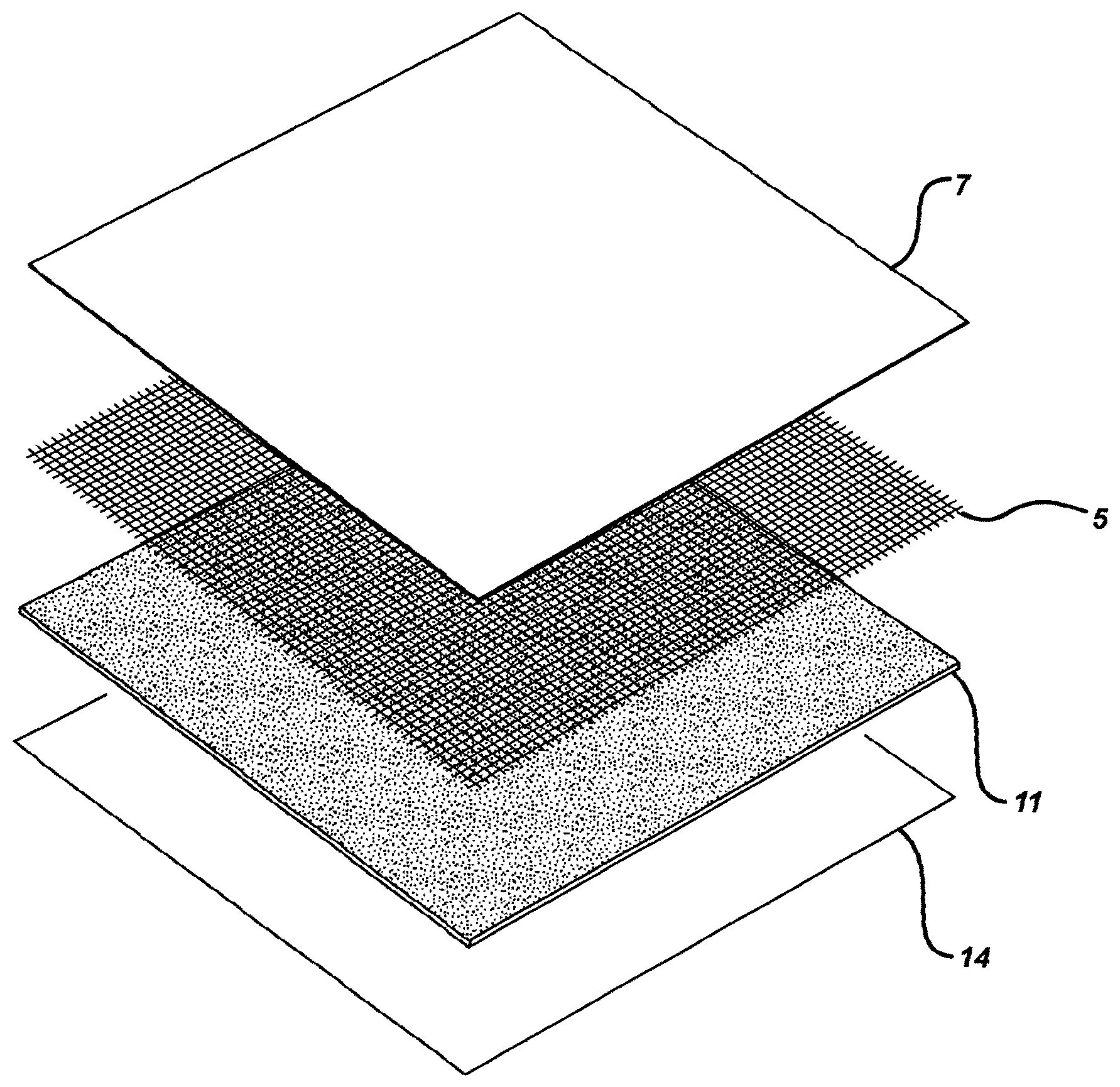
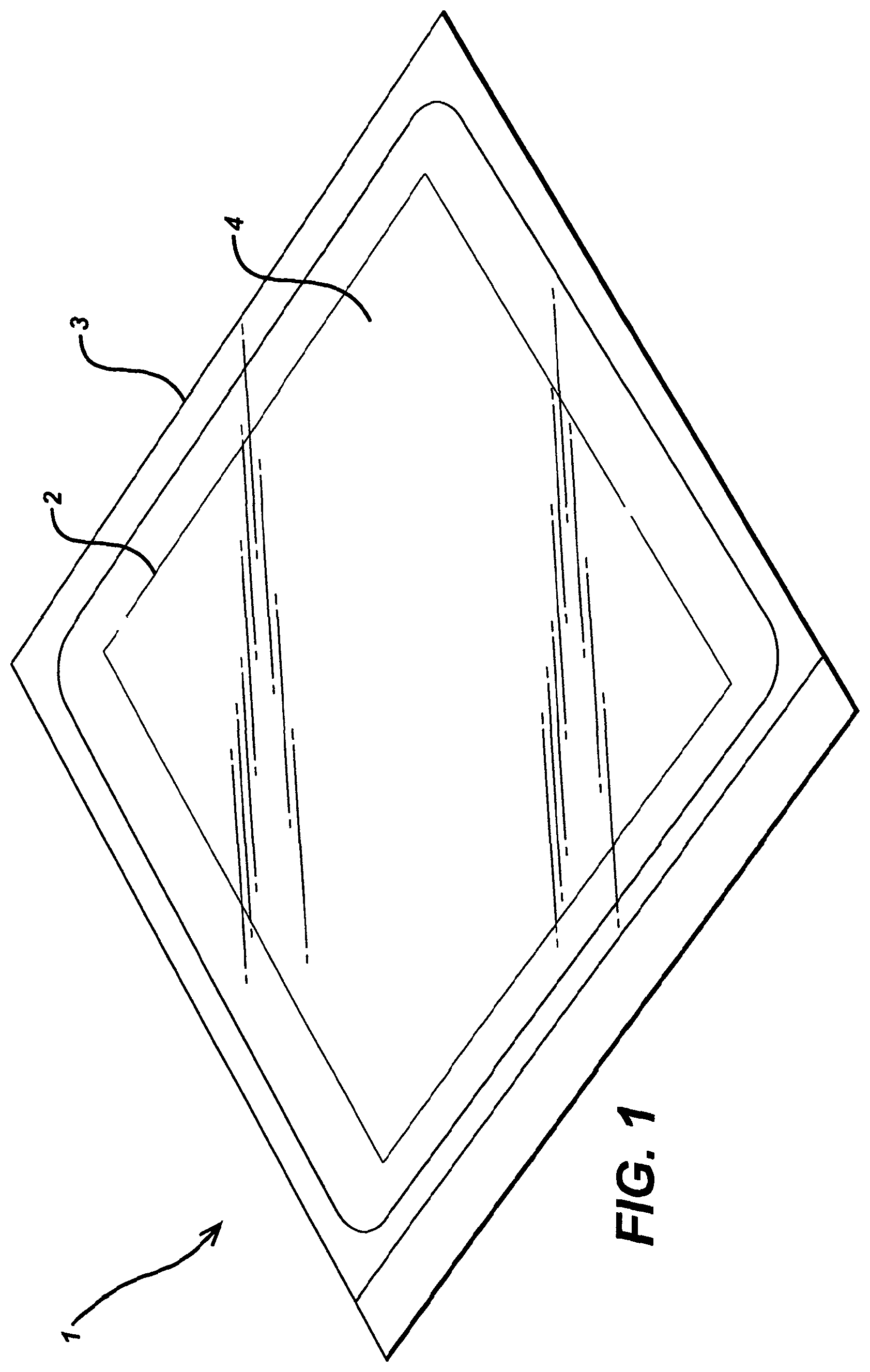
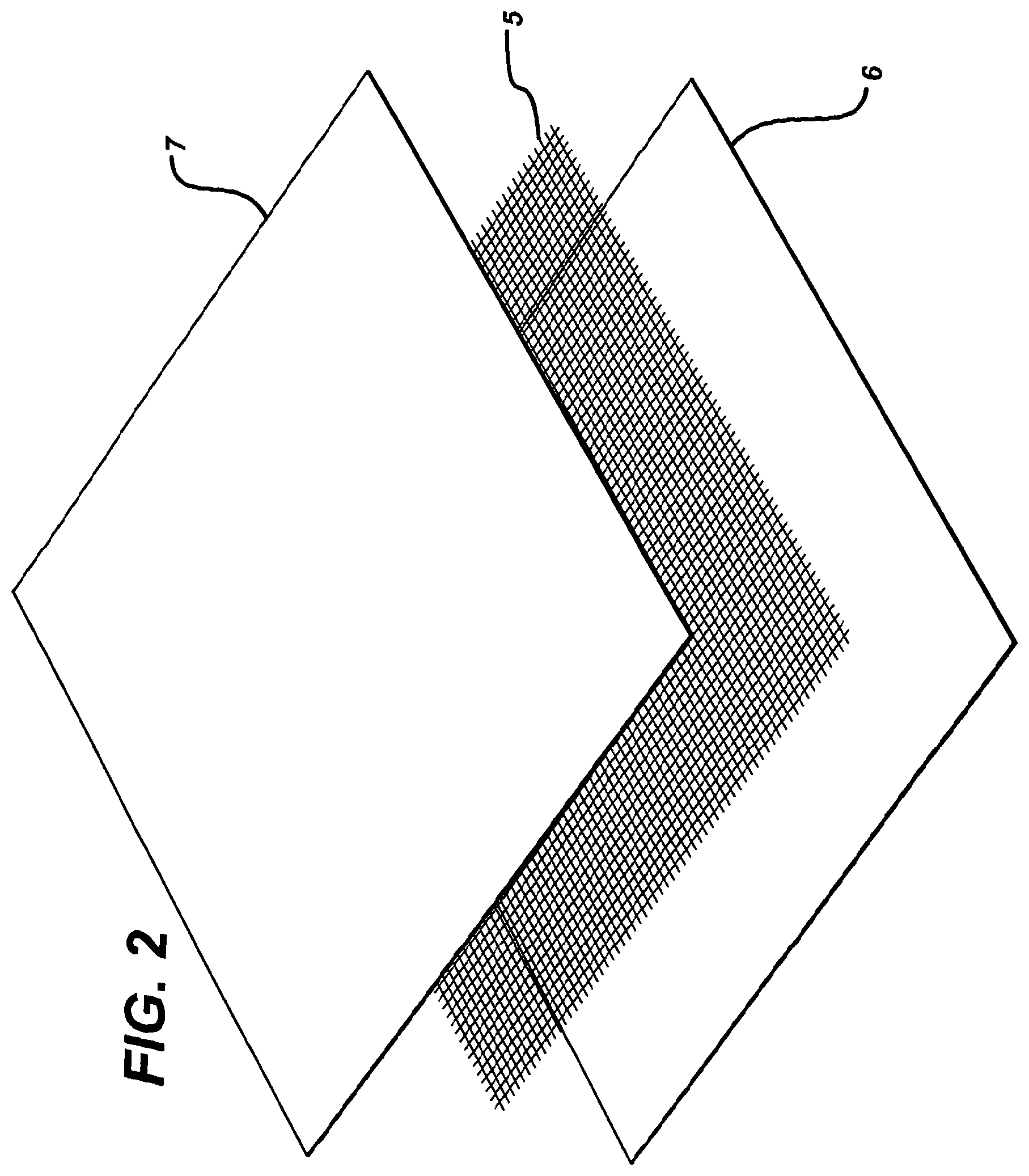
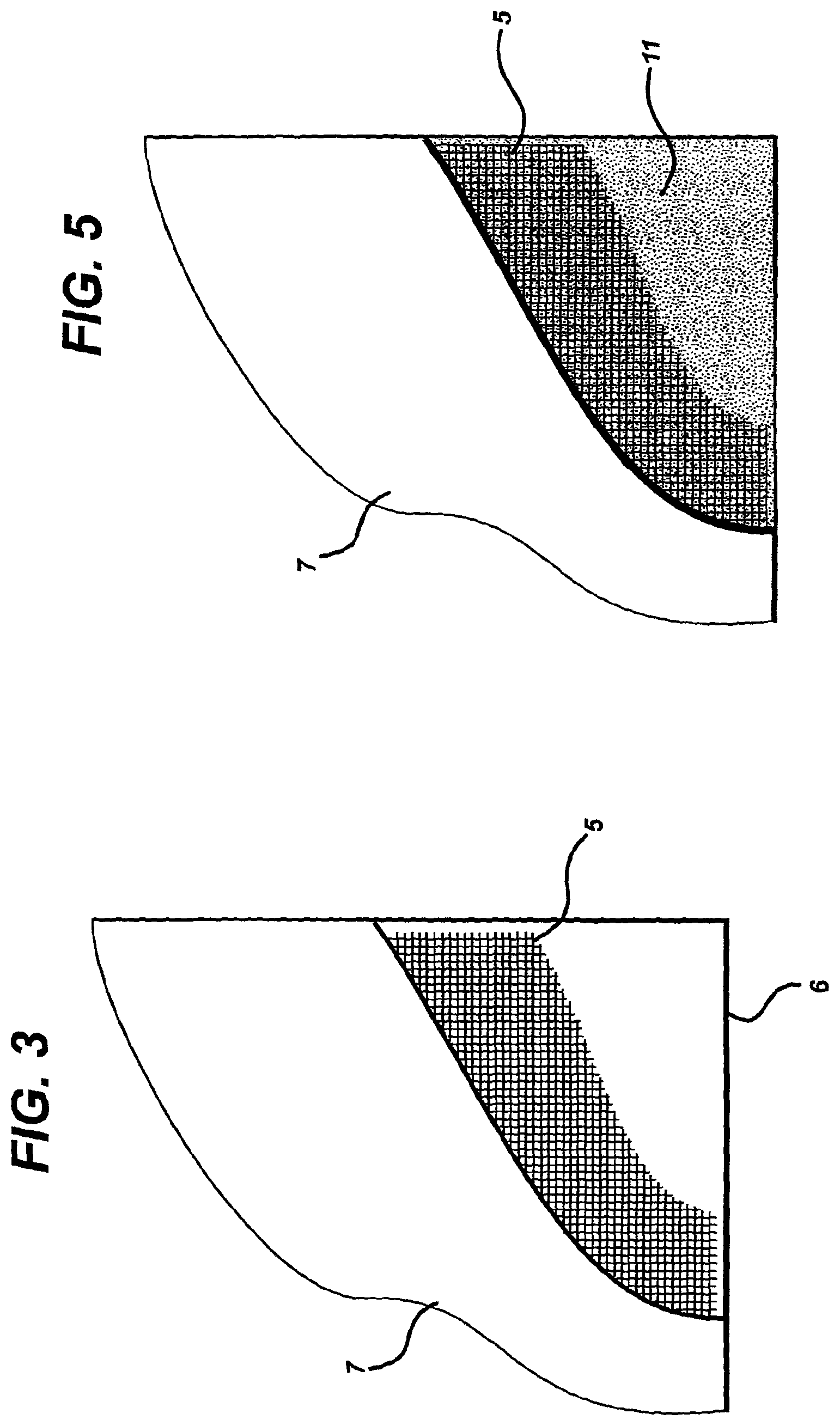
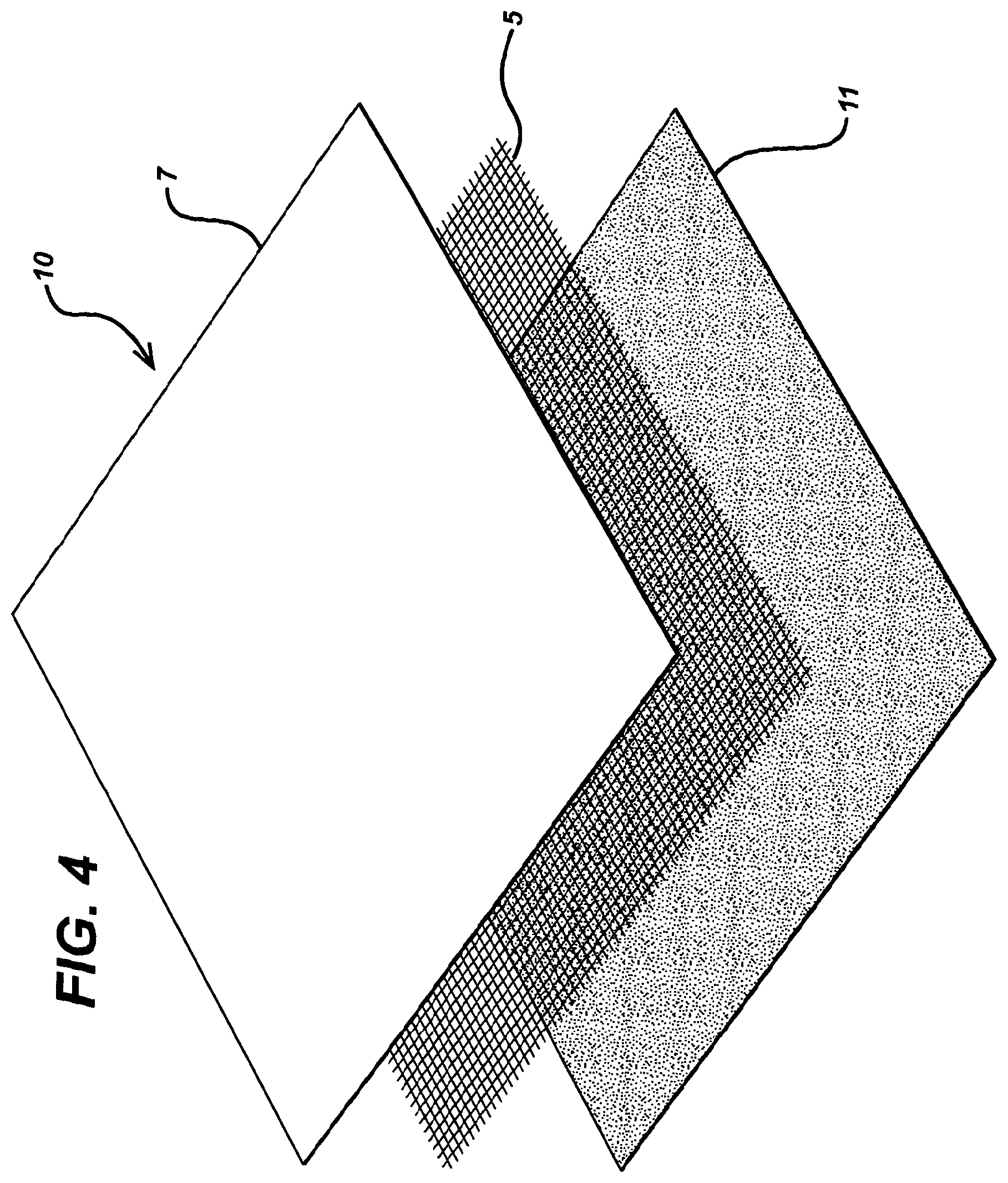
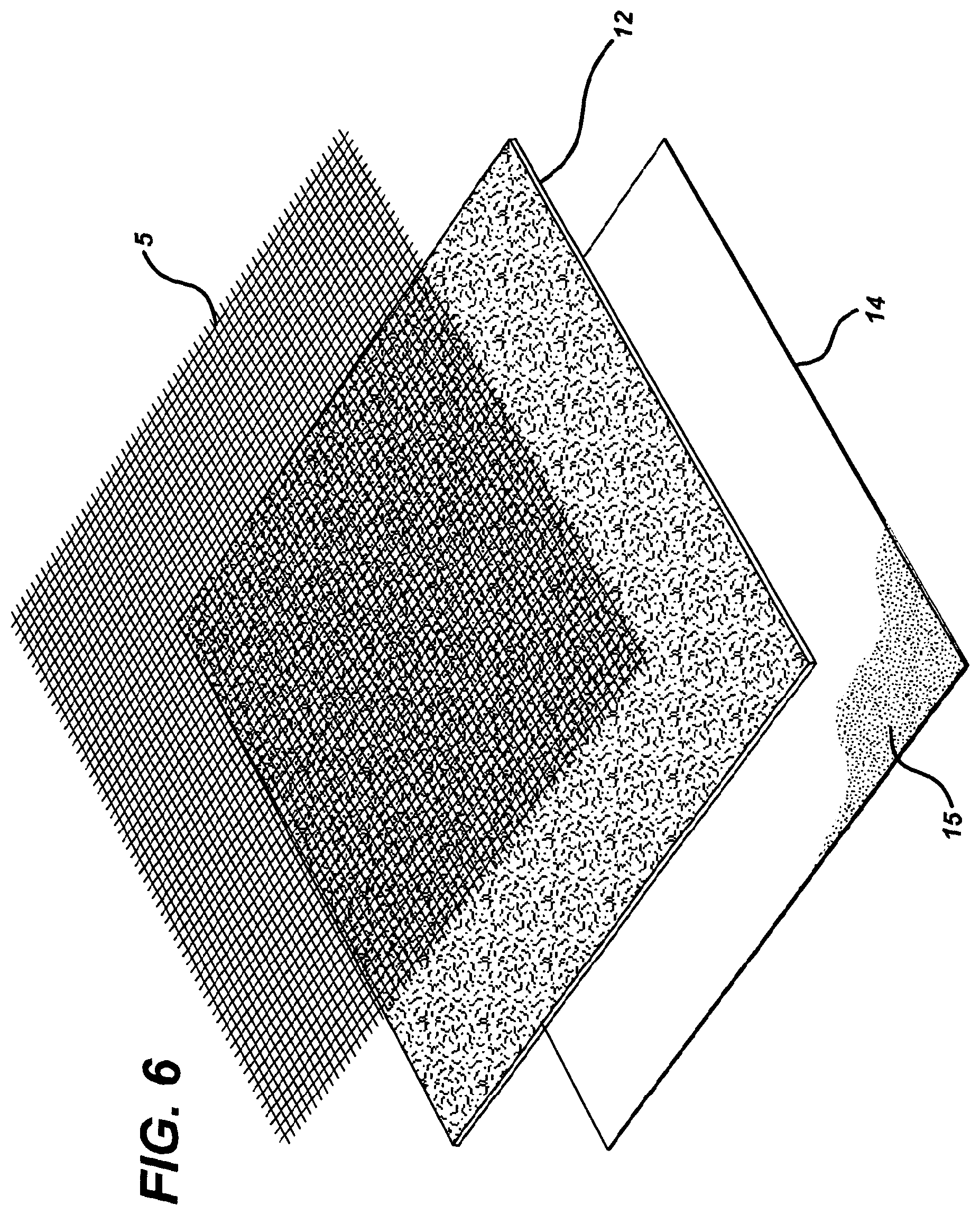
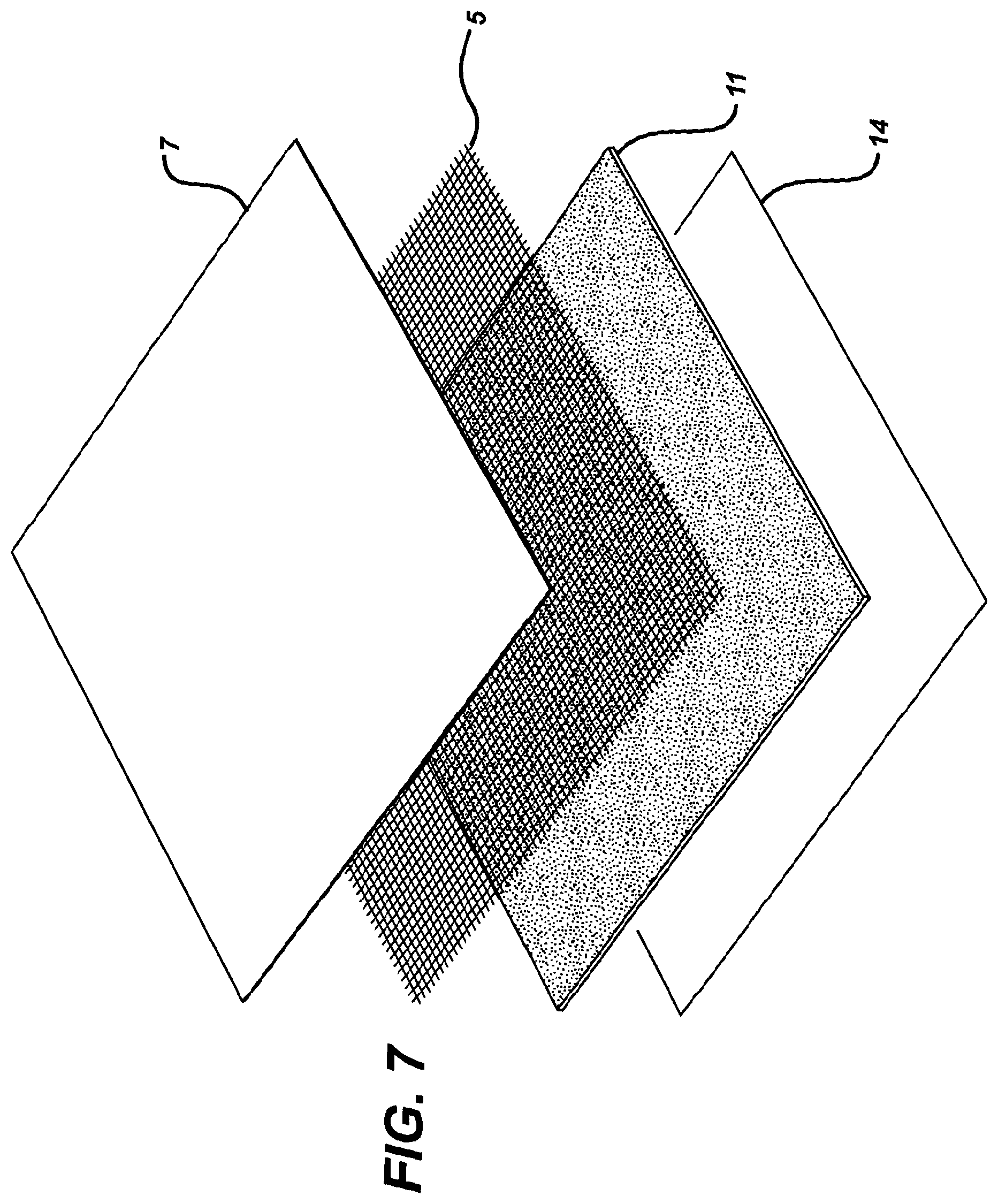
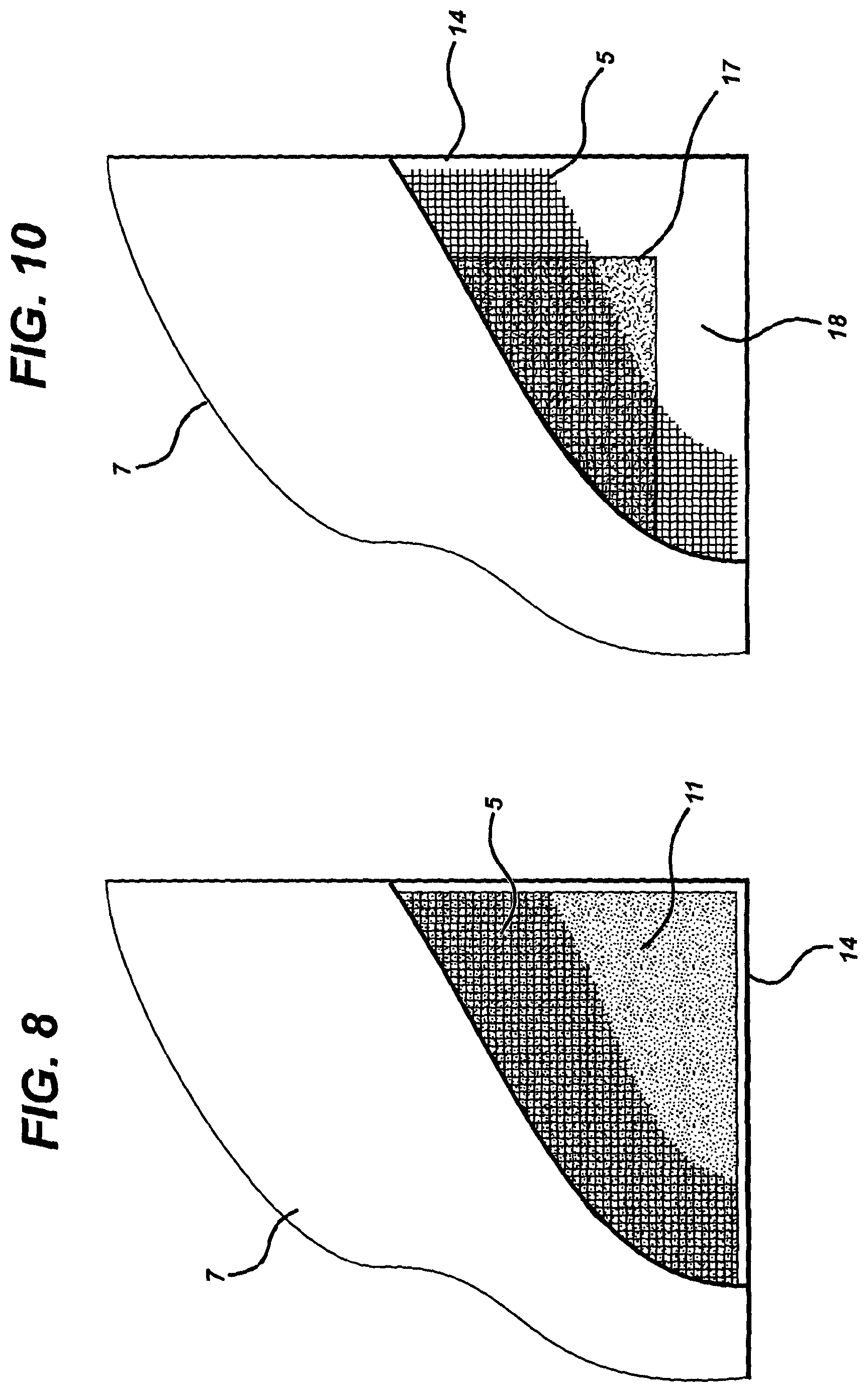
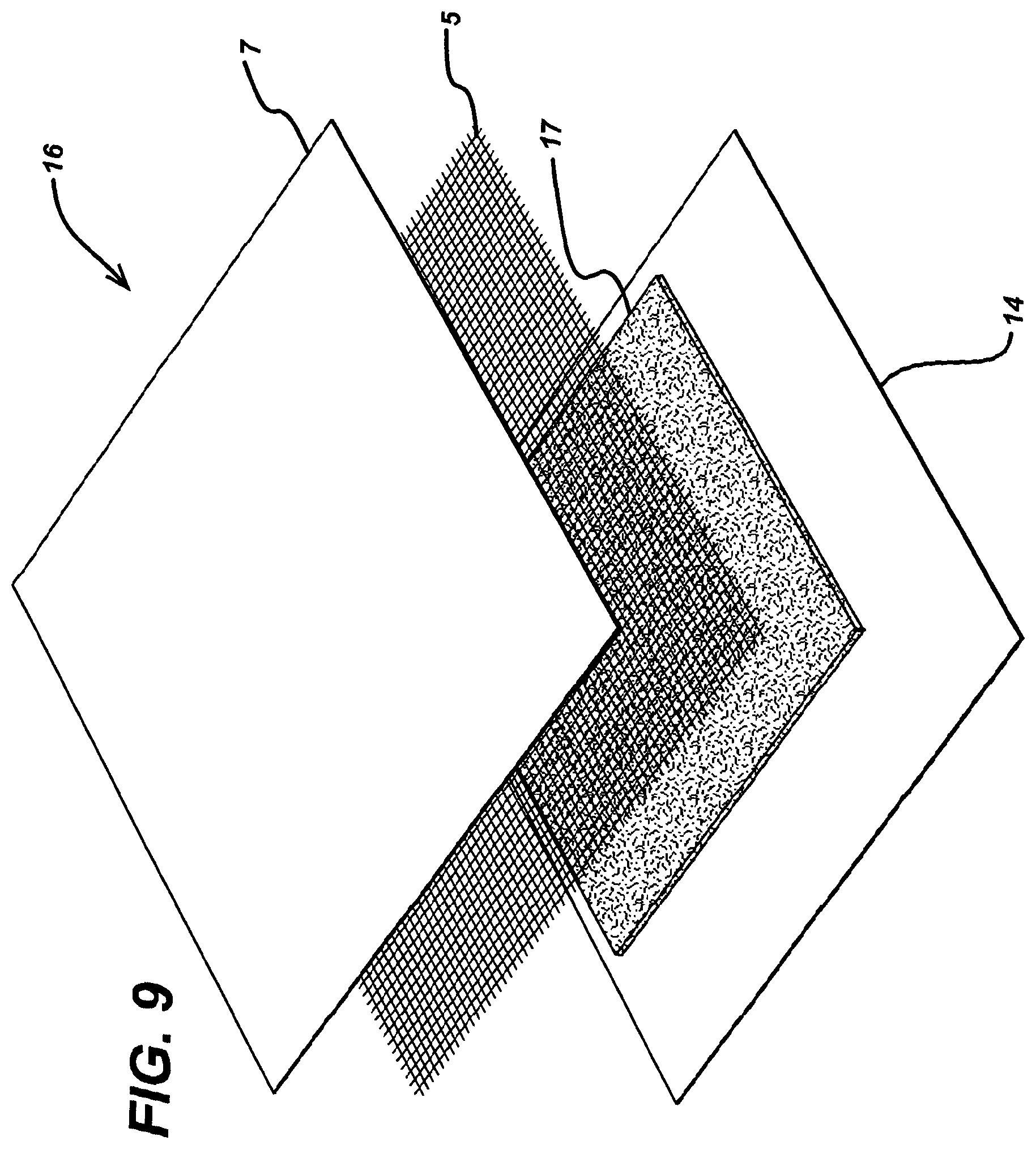
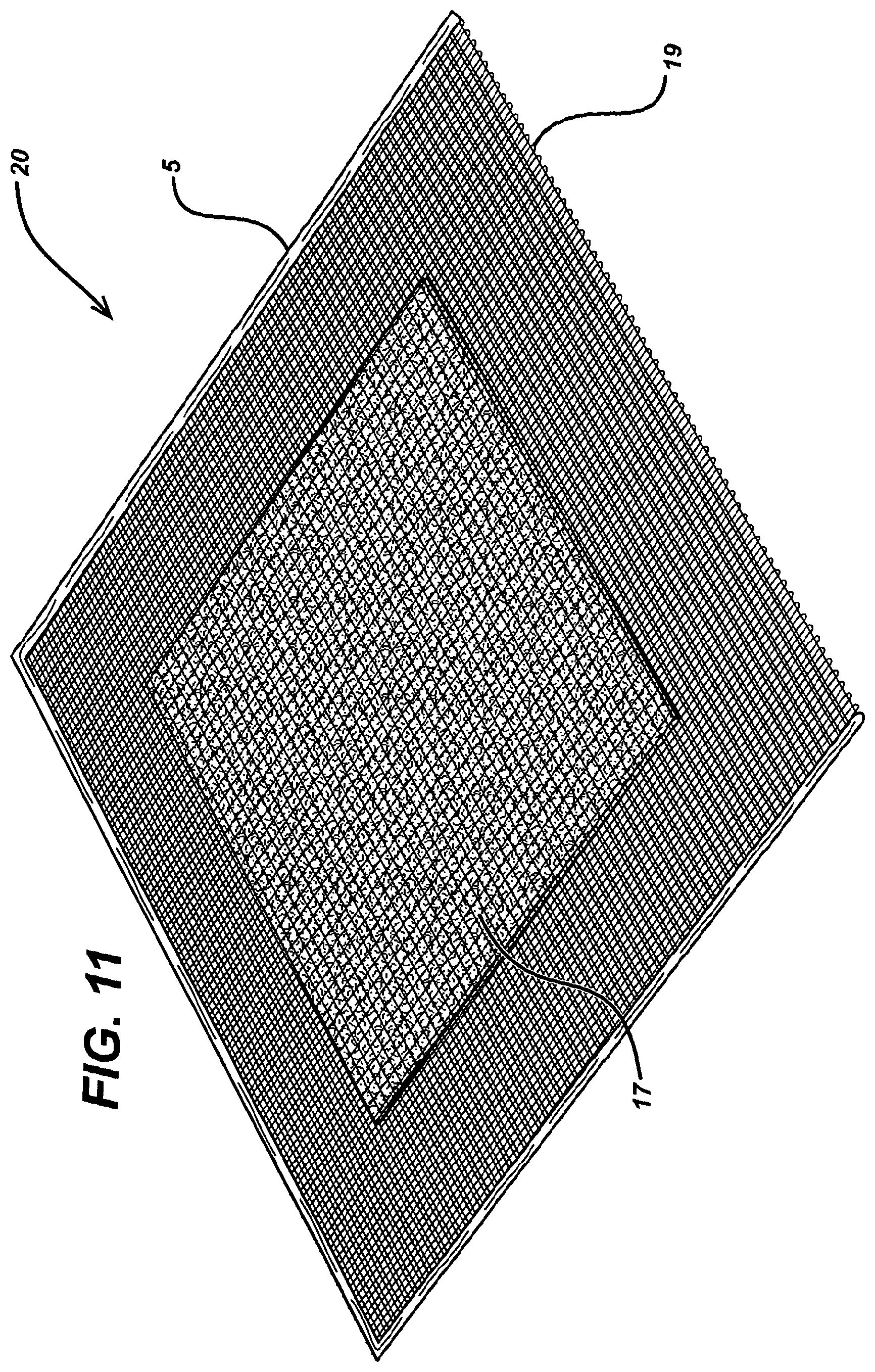
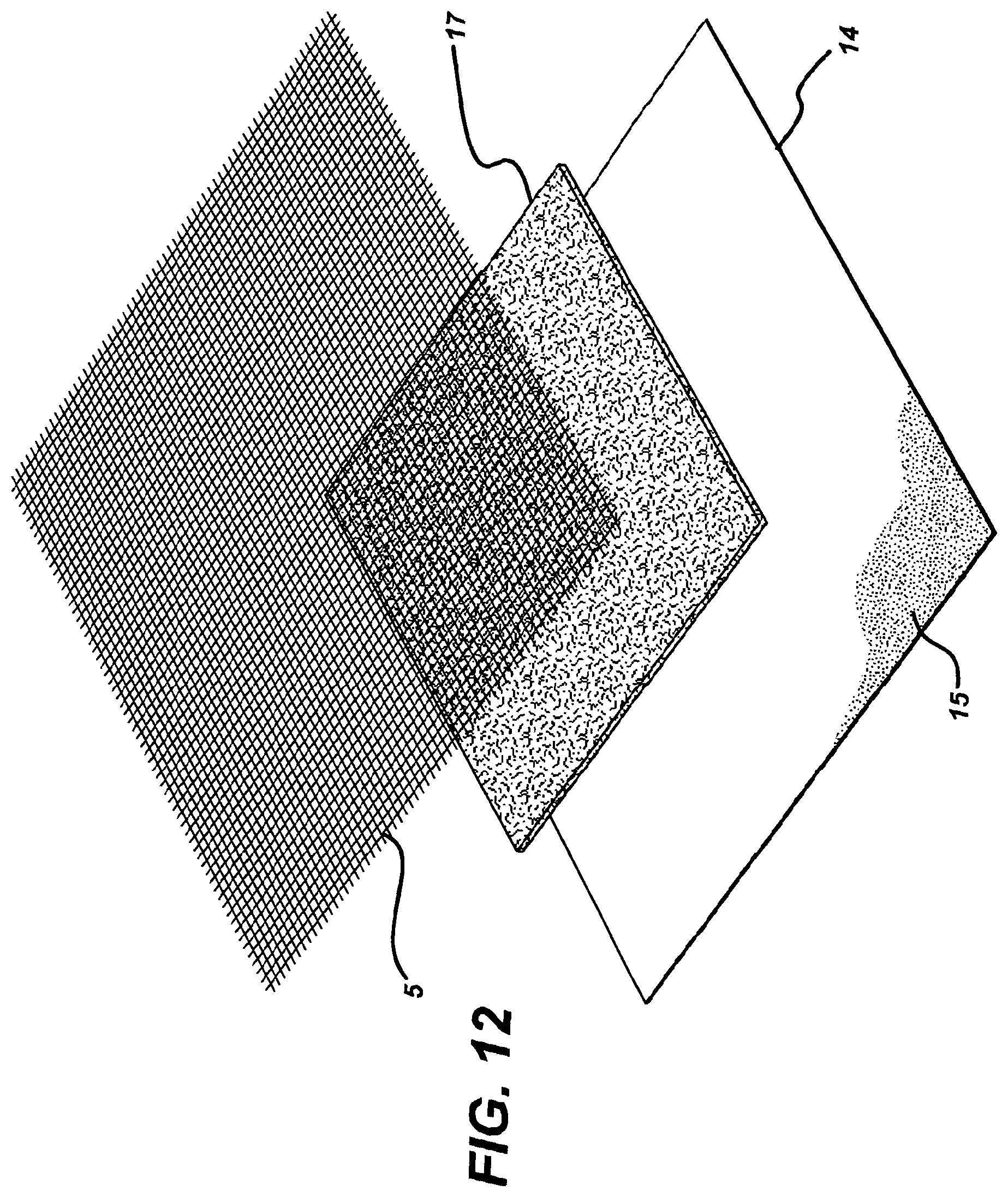
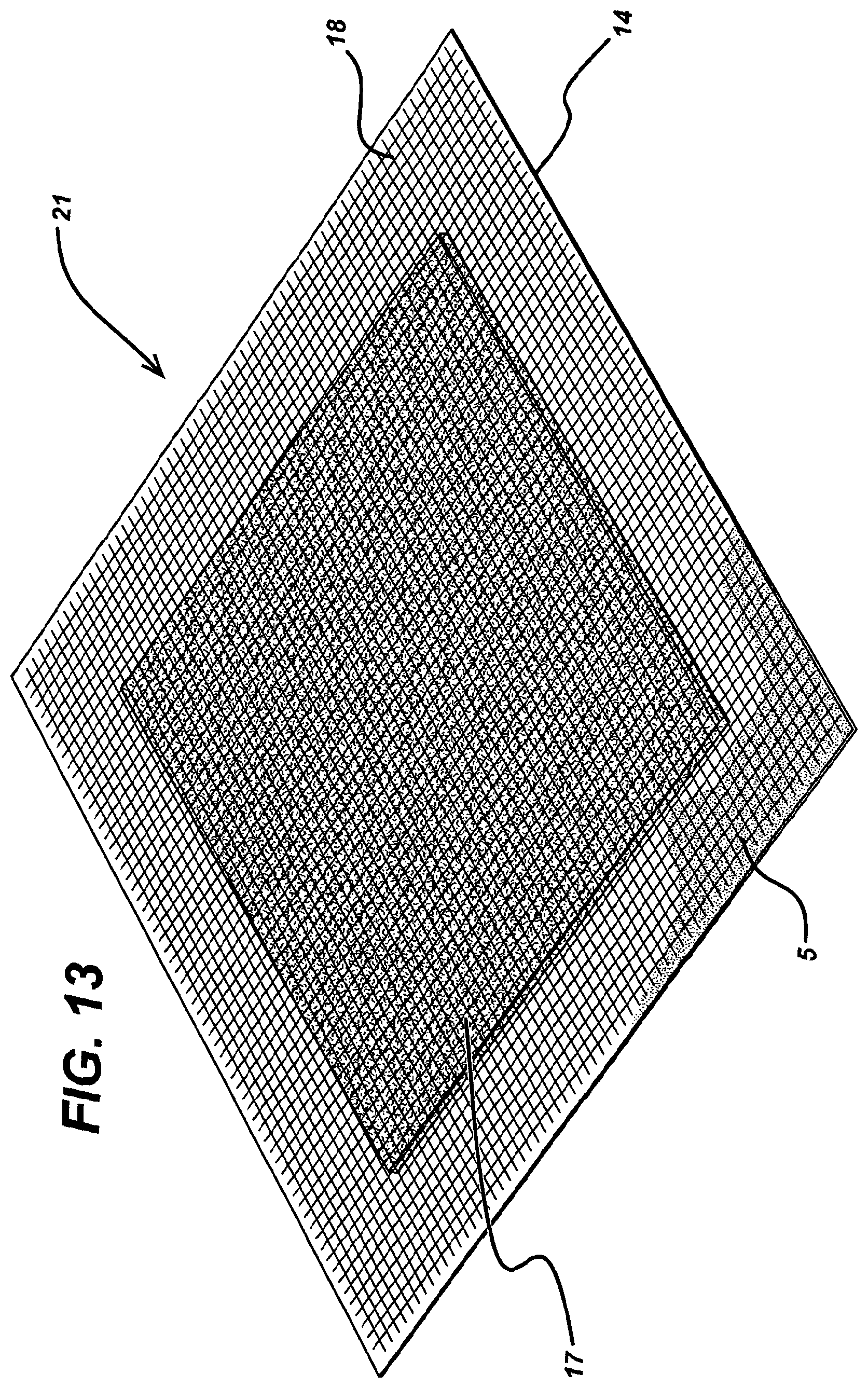
View All Diagrams
| United States Patent | 10,568,767 |
| Addison , et al. | February 25, 2020 |
Silicone wound dressing laminate and method for making the same
Abstract
A method of making a wound dressing comprising the steps of: providing an apertured substrate layer; coating the substrate layer with a fluid silicone prepolymer composition; thermally partially curing said silicone prepolymer composition to form a partially cured silicone coating on the substrate; laminating the coated substrate layer to a base layer to form a laminate having said partially cured silicone coating in contact with a surface of the base layer; followed by exposing the laminate to ionizing radiation, to further cure the partially cured silicone coating and to bond the silicone coating to said surface of the base layer. The radiation cure results in strong bonding between the siliconized substrate and incompatible base layers such as polyurethane foams. Also provided are wound dressings obtainable by the process of the invention.
| Inventors: | Addison; Deborah (Near Clampham, GB), Stephens; Sally (Skipton, GB), Brosnan; Patrick Joseph (West Yorkshire, GB) | ||||||||||
|---|---|---|---|---|---|---|---|---|---|---|---|
| Applicant: |
|
||||||||||
| Assignee: | KCI USA, INC. (San Antonio,
TX) |
||||||||||
| Family ID: | 43824886 | ||||||||||
| Appl. No.: | 13/982,650 | ||||||||||
| Filed: | January 31, 2012 | ||||||||||
| PCT Filed: | January 31, 2012 | ||||||||||
| PCT No.: | PCT/GB2012/000099 | ||||||||||
| 371(c)(1),(2),(4) Date: | November 13, 2013 | ||||||||||
| PCT Pub. No.: | WO2012/104584 | ||||||||||
| PCT Pub. Date: | August 09, 2012 |
Prior Publication Data
| Document Identifier | Publication Date | |
|---|---|---|
| US 20140058309 A1 | Feb 27, 2014 | |
Foreign Application Priority Data
| Jan 31, 2011 [GB] | 1101662.3 | |||
| Current U.S. Class: | 1/1 |
| Current CPC Class: | A61F 13/00029 (20130101); A61F 13/0203 (20130101); A61F 13/0213 (20130101); A61F 13/0276 (20130101); A61F 13/0223 (20130101); A61F 13/0226 (20130101); A61F 13/00987 (20130101); A61F 2013/00659 (20130101) |
| Current International Class: | A61F 13/00 (20060101); A61F 13/02 (20060101) |
| Field of Search: | ;604/304,307 ;424/443,445 ;427/2.31 ;602/41-43,47,52,54 |
References Cited [Referenced By]
U.S. Patent Documents
| 1355846 | October 1920 | Rannells |
| 2547758 | April 1951 | Kelling |
| 2632443 | March 1953 | Lesher |
| 2682873 | July 1954 | Evans et al. |
| 2910763 | November 1959 | Lauterbach |
| 2969057 | January 1961 | Simmons |
| 3066672 | December 1962 | Crosby, Jr. et al. |
| 3172808 | March 1965 | Baumann et al. |
| 3367332 | February 1968 | Groves |
| 3376868 | April 1968 | Mondiadis |
| 3520300 | July 1970 | Flower, Jr. |
| 3568675 | March 1971 | Harvey |
| 3648692 | March 1972 | Wheeler |
| 3682180 | August 1972 | McFarlane |
| 3742952 | July 1973 | Magers et al. |
| 3774611 | November 1973 | Tussey et al. |
| 3777016 | December 1973 | Gilbert |
| 3779243 | December 1973 | Tussey et al. |
| 3826254 | July 1974 | Mellor |
| 3852823 | December 1974 | Jones |
| 3903882 | September 1975 | Augurt |
| 3967624 | July 1976 | Milnamow |
| 3983297 | September 1976 | Ono et al. |
| 4060081 | November 1977 | Yannas |
| 4080970 | March 1978 | Miller |
| 4096853 | June 1978 | Weigand |
| 4139004 | February 1979 | Gonzalez, Jr. |
| 4141361 | February 1979 | Snyder |
| 4163822 | August 1979 | Walter |
| 4165748 | August 1979 | Johnson |
| 4184510 | January 1980 | Murry et al. |
| 4233969 | November 1980 | Lock et al. |
| 4245630 | January 1981 | Lloyd et al. |
| 4256109 | March 1981 | Nichols |
| 4261363 | April 1981 | Russo |
| 4275721 | June 1981 | Olson |
| 4284079 | August 1981 | Adair |
| 4297995 | November 1981 | Golub |
| 4333468 | June 1982 | Geist |
| 4360015 | November 1982 | Mayer |
| 4373519 | February 1983 | Errede et al. |
| 4382441 | May 1983 | Svedman |
| 4392853 | July 1983 | Muto |
| 4392858 | July 1983 | George et al. |
| 4414970 | November 1983 | Berry |
| 4419097 | December 1983 | Rowland |
| 4465485 | August 1984 | Kashmer et al. |
| 4475909 | October 1984 | Eisenberg |
| 4480638 | November 1984 | Schmid |
| 4525166 | June 1985 | Leclerc |
| 4525374 | June 1985 | Vaillancourt |
| 4529402 | July 1985 | Weilbacher et al. |
| 4540412 | September 1985 | Van Overloop |
| 4543100 | September 1985 | Brodsky |
| 4548202 | October 1985 | Duncan |
| 4551139 | November 1985 | Plaas et al. |
| 4569348 | February 1986 | Hasslinger |
| 4605399 | August 1986 | Weston et al. |
| 4608041 | August 1986 | Nielsen |
| 4640688 | February 1987 | Hauser |
| 4655754 | April 1987 | Richmond et al. |
| 4664652 | May 1987 | Weilbacher |
| 4664662 | May 1987 | Webster |
| 4710165 | December 1987 | McNeil et al. |
| 4715857 | December 1987 | Juhasz et al. |
| 4733659 | March 1988 | Edenbaum et al. |
| 4743232 | May 1988 | Kruger |
| 4753230 | June 1988 | Carus et al. |
| 4758220 | July 1988 | Sundblom et al. |
| 4787888 | November 1988 | Fox |
| 4826494 | May 1989 | Richmond et al. |
| 4832008 | May 1989 | Gilman |
| 4838253 | June 1989 | Brassington |
| 4838883 | June 1989 | Matsuura |
| 4840187 | June 1989 | Brazier |
| 4848364 | July 1989 | Bosman |
| 4863449 | September 1989 | Therriault et al. |
| 4871611 | October 1989 | Lebel |
| 4872450 | October 1989 | Austad |
| 4878901 | November 1989 | Sachse |
| 4897081 | January 1990 | Poirier et al. |
| 4906233 | March 1990 | Moriuchi et al. |
| 4906240 | March 1990 | Reed et al. |
| 4919654 | April 1990 | Kalt |
| 4930997 | June 1990 | Bennett |
| 4941882 | July 1990 | Ward et al. |
| 4953565 | September 1990 | Tachibana et al. |
| 4961493 | October 1990 | Kaihatsu |
| 4969880 | November 1990 | Zamierowski |
| 4981474 | January 1991 | Bopp et al. |
| 4985019 | January 1991 | Michelson |
| 4995382 | February 1991 | Lang et al. |
| 4996128 | February 1991 | Aldecoa et al. |
| 5010883 | April 1991 | Rawlings et al. |
| 5018515 | May 1991 | Gilman |
| 5028597 | July 1991 | Kodama |
| 5037397 | August 1991 | Kalt et al. |
| 5086170 | February 1992 | Luheshi et al. |
| 5092323 | March 1992 | Riedel et al. |
| 5092858 | March 1992 | Benson et al. |
| 5100396 | March 1992 | Zamierowski |
| 5112323 | May 1992 | Winkler et al. |
| 5134994 | August 1992 | Say |
| 5149331 | September 1992 | Ferdman et al. |
| 5151314 | September 1992 | Brown |
| 5152757 | October 1992 | Eriksson |
| 5167613 | December 1992 | Karami et al. |
| 5176663 | January 1993 | Svedman et al. |
| 5180375 | January 1993 | Feibus |
| 5215522 | June 1993 | Page et al. |
| 5232453 | August 1993 | Plass et al. |
| 5261893 | November 1993 | Zamierowski |
| 5266372 | November 1993 | Arakawa et al. |
| 5270358 | December 1993 | Asmus |
| 5278100 | January 1994 | Doan et al. |
| 5279550 | January 1994 | Habib et al. |
| 5298015 | March 1994 | Komatsuzaki et al. |
| 5342329 | August 1994 | Croquevielle |
| 5342376 | August 1994 | Ruff |
| 5344415 | September 1994 | DeBusk et al. |
| 5356386 | October 1994 | Goldberg et al. |
| 5358494 | October 1994 | Svedman |
| 5384174 | January 1995 | Ward et al. |
| 5387207 | February 1995 | Dyer et al. |
| 5419769 | May 1995 | Devlin et al. |
| 5423778 | June 1995 | Eriksson et al. |
| 5429590 | July 1995 | Saito et al. |
| 5437622 | August 1995 | Carion |
| 5437651 | August 1995 | Todd et al. |
| 5445604 | August 1995 | Lang |
| 5447492 | September 1995 | Cartmell et al. |
| 5501212 | March 1996 | Psaros |
| 5522808 | June 1996 | Skalla |
| 5527293 | June 1996 | Zamierowski |
| 5549584 | August 1996 | Gross |
| 5549585 | August 1996 | Maher et al. |
| 5556375 | September 1996 | Ewall |
| 5585178 | December 1996 | Calhoun et al. |
| 5599292 | February 1997 | Yoon |
| 5607388 | March 1997 | Ewall |
| 5634893 | June 1997 | Rishton |
| 5636643 | June 1997 | Argenta et al. |
| 5641506 | June 1997 | Talke et al. |
| 5645081 | July 1997 | Argenta et al. |
| 5653224 | August 1997 | Johnson |
| 5678564 | October 1997 | Lawrence et al. |
| 5710233 | January 1998 | Meckel et al. |
| 5714225 | February 1998 | Hansen et al. |
| 5736470 | April 1998 | Schneberger et al. |
| 5776119 | July 1998 | Bilbo et al. |
| 5807295 | September 1998 | Hutcheon et al. |
| 5919476 | July 1999 | Fischer et al. |
| 5941863 | August 1999 | Guidotti et al. |
| 5981822 | November 1999 | Addison |
| 5998561 | December 1999 | Jada |
| 6071267 | June 2000 | Zamierowski |
| 6086995 | July 2000 | Smith |
| 6135116 | October 2000 | Vogel et al. |
| 6174306 | January 2001 | Fleischmann |
| 6191335 | February 2001 | Robinson |
| 6241747 | June 2001 | Ruff |
| 6262329 | July 2001 | Brunsveld et al. |
| 6287316 | September 2001 | Agarwal et al. |
| 6345623 | February 2002 | Heaton et al. |
| 6458109 | October 2002 | Henley et al. |
| 6488643 | December 2002 | Tumey et al. |
| 6493568 | December 2002 | Bell et al. |
| 6495229 | December 2002 | Carte et al. |
| 6548727 | April 2003 | Swenson |
| 6553998 | April 2003 | Heaton et al. |
| 6566575 | May 2003 | Stickels et al. |
| 6566577 | May 2003 | Addison et al. |
| 6626891 | September 2003 | Ohmstede |
| 6627215 | September 2003 | Dale et al. |
| 6648862 | November 2003 | Watson |
| 6680113 | January 2004 | Lucast et al. |
| 6685681 | February 2004 | Lockwood et al. |
| 6693180 | February 2004 | Lee et al. |
| 6695823 | February 2004 | Lina et al. |
| 6752794 | June 2004 | Lockwood et al. |
| 6787682 | September 2004 | Gilman |
| 6814079 | November 2004 | Heaton et al. |
| 6855135 | February 2005 | Lockwood et al. |
| 6856821 | February 2005 | Johnson |
| 6979324 | December 2005 | Bybordi et al. |
| 7070584 | July 2006 | Johnson et al. |
| 7154017 | December 2006 | Sigurjonsson et al. |
| 7402721 | July 2008 | Sigurjonsson et al. |
| 7569742 | August 2009 | Haggstrom et al. |
| 7645269 | January 2010 | Zamierowski |
| 8298197 | October 2012 | Eriksson et al. |
| 8529532 | September 2013 | Pinto et al. |
| 8632523 | January 2014 | Eriksson et al. |
| 8764732 | July 2014 | Hartwell |
| 9192444 | November 2015 | Locke et al. |
| 2001/0030304 | October 2001 | Kohda et al. |
| 2001/0051178 | December 2001 | Blatchford et al. |
| 2002/0009568 | January 2002 | Bries et al. |
| 2002/0016346 | February 2002 | Brandt et al. |
| 2002/0065494 | May 2002 | Lockwood et al. |
| 2002/0077661 | June 2002 | Saadat |
| 2002/0115951 | August 2002 | Norstrem et al. |
| 2002/0119292 | August 2002 | Venkatasanthanam et al. |
| 2002/0120185 | August 2002 | Johnson |
| 2002/0130064 | September 2002 | Adams et al. |
| 2002/0143286 | October 2002 | Tumey |
| 2002/0150270 | October 2002 | Werner |
| 2002/0150720 | October 2002 | Howard et al. |
| 2002/0161346 | October 2002 | Lockwood et al. |
| 2002/0164346 | November 2002 | Nicolette |
| 2002/0183702 | December 2002 | Henley et al. |
| 2002/0198504 | December 2002 | Risk et al. |
| 2003/0014022 | January 2003 | Lockwood et al. |
| 2003/0109855 | June 2003 | Solem et al. |
| 2003/0158577 | August 2003 | Ginn et al. |
| 2003/0212357 | November 2003 | Pace |
| 2003/0225347 | December 2003 | Argenta et al. |
| 2003/0225355 | December 2003 | Butler |
| 2004/0002676 | January 2004 | Siegwart et al. |
| 2004/0030304 | February 2004 | Hunt et al. |
| 2004/0064132 | April 2004 | Boehringer et al. |
| 2004/0077984 | April 2004 | Worthley |
| 2004/0099268 | May 2004 | Smith et al. |
| 2004/0118401 | June 2004 | Smith et al. |
| 2004/0127836 | July 2004 | Sigurjonsson et al. |
| 2004/0127862 | July 2004 | Bubb et al. |
| 2004/0133143 | July 2004 | Burton et al. |
| 2004/0138604 | July 2004 | Sigurjonsson |
| 2004/0186239 | September 2004 | Qin et al. |
| 2004/0219337 | November 2004 | Langley et al. |
| 2004/0230179 | November 2004 | Shehada |
| 2005/0034731 | February 2005 | Rousseau et al. |
| 2005/0054998 | March 2005 | Poccia et al. |
| 2005/0059918 | March 2005 | Sigurjonsson et al. |
| 2005/0065484 | March 2005 | Watson |
| 2005/0070858 | March 2005 | Lockwood et al. |
| 2005/0101940 | May 2005 | Radl et al. |
| 2005/0113732 | May 2005 | Lawry |
| 2005/0124925 | June 2005 | Scherpenborg |
| 2005/0131327 | June 2005 | Lockwood et al. |
| 2005/0137539 | June 2005 | Biggie et al. |
| 2005/0143694 | June 2005 | Schmidt et al. |
| 2005/0159695 | July 2005 | Cullen |
| 2005/0161042 | July 2005 | Fudge et al. |
| 2005/0163978 | July 2005 | Strobech et al. |
| 2005/0214376 | September 2005 | Faure et al. |
| 2005/0233072 | October 2005 | Stephan et al. |
| 2005/0256437 | November 2005 | Silcock et al. |
| 2005/0261642 | November 2005 | Weston |
| 2005/0261643 | November 2005 | Bybordi et al. |
| 2005/0277860 | December 2005 | Jensen |
| 2006/0079852 | April 2006 | Bubb et al. |
| 2006/0083776 | April 2006 | Bott et al. |
| 2006/0154546 | July 2006 | Murphy et al. |
| 2006/0241542 | October 2006 | Gudnason |
| 2006/0271020 | November 2006 | Huang et al. |
| 2007/0027414 | February 2007 | Hoffman et al. |
| 2007/0078366 | April 2007 | Haggstrom et al. |
| 2007/0185426 | August 2007 | Ambrosio et al. |
| 2007/0225663 | September 2007 | Watt et al. |
| 2007/0265585 | November 2007 | Joshi et al. |
| 2007/0265586 | November 2007 | Joshi et al. |
| 2008/0090085 | April 2008 | Kawate et al. |
| 2008/0119802 | May 2008 | Riesinger |
| 2008/0149104 | June 2008 | Eifler |
| 2008/0195017 | August 2008 | Robinson et al. |
| 2008/0225663 | September 2008 | Smith et al. |
| 2008/0243044 | October 2008 | Hunt et al. |
| 2008/0269657 | October 2008 | Brenneman et al. |
| 2008/0271804 | November 2008 | Biggie et al. |
| 2009/0025724 | January 2009 | Herron, Jr. |
| 2009/0088719 | April 2009 | Driskell |
| 2009/0093779 | April 2009 | Riesinger |
| 2009/0124988 | May 2009 | Coulthard |
| 2009/0177172 | July 2009 | Wilkes |
| 2009/0216204 | August 2009 | Bhavaraju et al. |
| 2009/0227969 | September 2009 | Jaeb et al. |
| 2009/0264807 | October 2009 | Haggstrom et al. |
| 2009/0292264 | November 2009 | Hudspeth et al. |
| 2009/0312662 | December 2009 | Colman et al. |
| 2009/0326488 | December 2009 | Budig et al. |
| 2010/0063467 | March 2010 | Addison et al. |
| 2010/0106106 | April 2010 | Heaton et al. |
| 2010/0106118 | April 2010 | Heaton et al. |
| 2010/0125259 | May 2010 | Olson |
| 2010/0159192 | June 2010 | Cotton |
| 2010/0185163 | July 2010 | Heagle |
| 2010/0226824 | September 2010 | Ophir et al. |
| 2010/0262090 | October 2010 | Riesinger |
| 2010/0267302 | October 2010 | Kantner et al. |
| 2010/0305490 | December 2010 | Coulthard et al. |
| 2010/0305524 | December 2010 | Vess et al. |
| 2010/0324516 | December 2010 | Braga et al. |
| 2011/0046585 | February 2011 | Weston |
| 2011/0137271 | June 2011 | Andresen et al. |
| 2011/0160686 | June 2011 | Ueda et al. |
| 2011/0171480 | July 2011 | Mori et al. |
| 2011/0172617 | July 2011 | Riesinger |
| 2011/0224631 | September 2011 | Simmons et al. |
| 2011/0229688 | September 2011 | Cotton |
| 2011/0244010 | October 2011 | Doshi |
| 2011/0257617 | October 2011 | Franklin |
| 2012/0016322 | January 2012 | Coulthard et al. |
| 2012/0123359 | May 2012 | Reed |
| 2012/0143157 | June 2012 | Riesinger |
| 2012/0258271 | October 2012 | Maughan |
| 2013/0030394 | January 2013 | Locke et al. |
| 2013/0066285 | March 2013 | Locke et al. |
| 2013/0096518 | April 2013 | Hall et al. |
| 2013/0152945 | June 2013 | Locke et al. |
| 2013/0165837 | June 2013 | Addison |
| 2014/0039423 | February 2014 | Riesinger |
| 2014/0039424 | February 2014 | Locke |
| 2014/0155849 | June 2014 | Heaton et al. |
| 2014/0171851 | June 2014 | Addison |
| 2014/0309574 | October 2014 | Cotton |
| 2014/0350494 | November 2014 | Hartwell et al. |
| 2015/0030848 | January 2015 | Goubard |
| 2015/0119830 | April 2015 | Luckemeyer et al. |
| 2015/0190286 | July 2015 | Allen et al. |
| 2016/0067107 | March 2016 | Cotton |
| 550575 | Mar 1986 | AU | |||
| 745271 | Mar 2002 | AU | |||
| 755496 | Dec 2002 | AU | |||
| 2009200608 | Oct 2009 | AU | |||
| 2005436 | Jun 1990 | CA | |||
| 87101823 | Aug 1988 | CN | |||
| 26 40 413 | Mar 1978 | DE | |||
| 43 06 478 | Sep 1994 | DE | |||
| 29 504 378 | Sep 1995 | DE | |||
| 202004018245 | Jul 2005 | DE | |||
| 097517 | Jan 1984 | EP | |||
| 0100148 | Feb 1984 | EP | |||
| 0117632 | Sep 1984 | EP | |||
| 0147119 | Jul 1985 | EP | |||
| 0161865 | Nov 1985 | EP | |||
| 0275353 | Jul 1988 | EP | |||
| 0358302 | Mar 1990 | EP | |||
| 0538917 | Apr 1993 | EP | |||
| 0630629 | Dec 1994 | EP | |||
| 0659390 | Jun 1995 | EP | |||
| 0633758 | Oct 1996 | EP | |||
| 0 251 810 | Jan 1998 | EP | |||
| 1 002 846 | May 2000 | EP | |||
| 1018967 | Jul 2000 | EP | |||
| 2578193 | Apr 2013 | EP | |||
| 692578 | Jun 1953 | GB | |||
| 1386800 | Mar 1975 | GB | |||
| 2 195 255 | Apr 1988 | GB | |||
| 2 197 789 | Jun 1988 | GB | |||
| 2 220 357 | Jan 1990 | GB | |||
| 2 235 877 | Mar 1991 | GB | |||
| 2 329 127 | Mar 1999 | GB | |||
| 2 333 965 | Aug 1999 | GB | |||
| 2377939 | Jan 2003 | GB | |||
| 2392836 | Mar 2004 | GB | |||
| 2393655 | Apr 2004 | GB | |||
| 2425487 | Nov 2006 | GB | |||
| 2452720 | Mar 2009 | GB | |||
| 2496310 | May 2013 | GB | |||
| 1961003393 | Feb 1961 | JP | |||
| S62139523 | Sep 1987 | JP | |||
| S62-275456 | Nov 1987 | JP | |||
| 2007254515 | Oct 2007 | JP | |||
| 2008080137 | Apr 2008 | JP | |||
| 4129536 | Aug 2008 | JP | |||
| 71559 | Apr 2002 | SG | |||
| 80/02182 | Oct 1980 | WO | |||
| 87/04626 | Aug 1987 | WO | |||
| 8707164 | Dec 1987 | WO | |||
| 90/010424 | Sep 1990 | WO | |||
| 93/009727 | May 1993 | WO | |||
| 94/020041 | Sep 1994 | WO | |||
| 96/05873 | Feb 1996 | WO | |||
| 9622753 | Aug 1996 | WO | |||
| 97/18007 | May 1997 | WO | |||
| 99/13793 | Mar 1999 | WO | |||
| 99/65542 | Dec 1999 | WO | |||
| 01019306 | Mar 2001 | WO | |||
| 01/36188 | May 2001 | WO | |||
| 01/60296 | Aug 2001 | WO | |||
| 0168021 | Sep 2001 | WO | |||
| 0185248 | Nov 2001 | WO | |||
| 0185248 | Nov 2001 | WO | |||
| 01085248 | Nov 2001 | WO | |||
| 0243743 | Jun 2002 | WO | |||
| 02062403 | Aug 2002 | WO | |||
| 03-018098 | Mar 2003 | WO | |||
| 03045294 | Jun 2003 | WO | |||
| 03045492 | Jun 2003 | WO | |||
| 03053484 | Jul 2003 | WO | |||
| 2004024197 | Mar 2004 | WO | |||
| 2004037334 | May 2004 | WO | |||
| 2004112852 | Dec 2004 | WO | |||
| 2005002483 | Jan 2005 | WO | |||
| 2005062896 | Jul 2005 | WO | |||
| 2005105176 | Nov 2005 | WO | |||
| 2005123170 | Dec 2005 | WO | |||
| 2007022097 | Feb 2007 | WO | |||
| 2007030601 | Mar 2007 | WO | |||
| 2007070269 | Jun 2007 | WO | |||
| 2007085396 | Aug 2007 | WO | |||
| 2007087811 | Aug 2007 | WO | |||
| 2007113597 | Oct 2007 | WO | |||
| 2007133618 | Nov 2007 | WO | |||
| 2008041926 | Apr 2008 | WO | |||
| 2008054312 | May 2008 | WO | |||
| 2008/082444 | Jul 2008 | WO | |||
| 2008100440 | Aug 2008 | WO | |||
| 2008104609 | Sep 2008 | WO | |||
| 2008/131895 | Nov 2008 | WO | |||
| 2009/002260 | Dec 2008 | WO | |||
| 2008149107 | Dec 2008 | WO | |||
| 2009066105 | May 2009 | WO | |||
| 2009066106 | May 2009 | WO | |||
| 2009081134 | Jul 2009 | WO | |||
| 2009089016 | Jul 2009 | WO | |||
| 2009/124100 | Oct 2009 | WO | |||
| 2009126103 | Oct 2009 | WO | |||
| 2010032728 | Mar 2010 | WO | |||
| 2010/056977 | May 2010 | WO | |||
| 2010129299 | Nov 2010 | WO | |||
| 2011008497 | Jan 2011 | WO | |||
| 2011/049562 | Apr 2011 | WO | |||
| 2011043786 | Apr 2011 | WO | |||
| 2011115908 | Sep 2011 | WO | |||
| 2011121127 | Oct 2011 | WO | |||
| 2011162862 | Dec 2011 | WO | |||
| 2012/112204 | Aug 2012 | WO | |||
| 2012104584 | Aug 2012 | WO | |||
| 2012140378 | Oct 2012 | WO | |||
| 2012143665 | Oct 2012 | WO | |||
| 2013009239 | Jan 2013 | WO | |||
| 2013090810 | Jun 2013 | WO | |||
| 2014039557 | Mar 2014 | WO | |||
| 2014/113253 | Jul 2014 | WO | |||
| 2014140608 | Sep 2014 | WO | |||
| 2014143488 | Sep 2014 | WO | |||
| 2015/065615 | May 2015 | WO | |||
| 2015130471 | Sep 2015 | WO | |||
Other References
|
EP Examination Report dated May 22, 2014 for EP. cited by applicant . International Search Report and Written Opinion for PCT/GB2008/003075 dated Mar. 11, 2010. cited by applicant . International Search Report and Written Opinion for PCT/GB2008/004216 dated Jul. 2, 2009. cited by applicant . International Search Report and Written Opinion for PCT/US2012/069893 dated Apr. 8, 2013. cited by applicant . Louis C. Argenta, MD and Michael J. Morykwas, PHD; Vacuum-Assisted Closure: A New Method for Wound Control and Treatment: Clinical Experience; Annals of Plastic Surgery. cited by applicant . Susan Mendez-Eatmen, RN; "When wounds Won't Heal" RN Jan. 1998, vol. 61 (1); Medical Economics Company, Inc., Montvale, NJ, USA; pp. 20-24. cited by applicant . James H. Blackburn II, MD et al.: Negative-Pressure Dressings as a Bolster for Skin Grafts; Annals of Plastic Surgery, vol. 40, No. 5, May 1998, pp. 453-457; Lippincott Williams & Wilkins, Inc., Philidelphia, PA, USA. cited by applicant . John Masters; "Reliable, Inexpensive and Simple Suction Dressings"; Letter to the Editor, British Journal of Plastic Surgery, 198, vol. 51 (3), p. 267; Elsevier Science/the British Association of Plastic Surgeons, UK. cited by applicant . S.E. Greer, et al. "The Use of Subatmospheric Pressure Dressing Therapy to Close Lymphocutaneous Fistulas of the Groin" British Journal of Plastic Surgery (2000), 53, pp. 484-487. cited by applicant . George V. Letsou, MD., et al; "Stimulation of Adenylate Cyclase Activity in Cultured Endothelial Cells Subjected to Cyclic Stretch"; Journal of Cardiovascular Surgery, 31, 1990, pp. 634-639. cited by applicant . Orringer, Jay, et al; "Management of Wounds in Patients with Complex Enterocutaneous Fistulas"; Surgery, Gynecology & Obstetrics, Jul. 1987, vol. 165, pp. 79-80. cited by applicant . International Search Report for PCT International Application PCT/GB95/01983; dated Nov. 23, 1995. cited by applicant . PCT International Search Report for PCT International Application PCT/GB98/02713; dated Jan. 8, 1999. cited by applicant . PCT Written Opinion; PCT International Application PCT/GB98/02713; dated Jun. 8, 1999. cited by applicant . PCT International Examination and Search Report, PCT International Application PCT/GB96/02802; dated Jan. 15, 1998 & Apr. 29, 1997. cited by applicant . PCT Written Opinion, PCT International Application PCT/GB96/02802; dated Sep. 3, 1997. cited by applicant . Dattilo, Philip P., Jr., et al; "Medical Textiles: Application of an Absorbable Barbed Bi-directional Surgical Suture"; Journal of Textile and Apparel, Technology and Management, vol. 2, Issue 2, Spring 2002, pp. 1-5. cited by applicant . Kostyuchenok, B.M., et al; "Vacuum Treatment in the Surgical Management of Purulent Wounds"; Vestnik Khirurgi, Sep. 1986, pp. 18-21 and 6 page English translation thereof. cited by applicant . Davydov, Yu. A., et al; "Vacuum Therapy in the Treatment of Purulent Lactation Mastitis"; Vestnik Khirurgi, May 14, 1986, pp. 66-70, and 9 page English translation thereof. cited by applicant . Yusupov. Yu.N., et al; "Active Wound Drainage", Vestnki Khirurgi, vol. 138, Issue 4, 1987, and 7 page English translation thereof. cited by applicant . Davydov, Yu.A., et al; "Bacteriological and Cytological Assessment of Vacuum Therapy for Purulent Wounds"; Vestnik Khirugi, Oct. 1988, pp. 48-52, and 8 page English translation thereof. cited by applicant . Davydov, Yu.A., et al; "Concepts for the Clinical-Biological Management of the Wound Process in the Treatment of Purulent Wounds by Means of Vacuum Therapy"; Vestnik Khirurgi, Jul. 7, 1980, pp. 132-136, and 8 page English translation thereof. cited by applicant . Chariker, Mark E., M.D., et al; "Effective Management of incisional and cutaneous fistulae with closed suction wound drainage"; Contemporary Surgery, vol. 34, Jun. 1989, pp. 59-63. cited by applicant . Egnell Minor, Instruction Book, First Edition, 300 7502, Feb. 1975, pp. 24. cited by applicant . Egnell Minor: Addition to the Users Manual Concerning Overflow Protection--Concerns all Egnell Pumps, Feb. 3, 1983, pp. 2. cited by applicant . Svedman, P.: "Irrigation Treatment of Leg Ulcers", The Lancet, Sep. 3, 1983, pp. 532-534. cited by applicant . Chinn, Steven D. et al.: "Closed Wound Suction Drainage", The Journal of Foot Surgery, vol. 24, No. 1, 1985, pp. 76-81. cited by applicant . Arnljots, Bjorn et al.: "Irrigation Treatment in Split-Thickness Skin Grafting of Intractable Leg Ulcers", Scand J. Plast Reconstr. Surg., No. 19, 1985, pp. 211-213. cited by applicant . Svedman, P.: "A Dressing Allowing Continuous Treatment of a Biosurface", IRCS Medical Science: Biomedical Technology, Clinical Medicine, Surgery and Transplantation, vol. 7, 1979, p. 221. cited by applicant . Svedman, P. et al: "A Dressing System Providing Fluid Supply and Suction Drainage Used for Continuous of Intermittent Irrigation", Annals of Plastic Surgery, vol. 17, No. 2, Aug. 1986, pp. 125-133. cited by applicant . N. A. Bagautdinov, "Variant of External Vacuum Aspiration in the Treatment of Purulent Diseases of Soft Tissues," Current Problems in Modern Clinical Surgery: Interdepartmental Collection, edited by V. Ye Volkov et al. (Chuvashia State University, Cheboksary, U.S.S.R. 1986); pp. 94-96 (copy and certified translation). cited by applicant . K.F. Jeter, T.E. Tintle, and M. Chariker, "Managing Draining Wounds and Fistulae: New and Established Methods," Chronic Wound Care, edited by D. Krasner (Health Management Publications, Inc., King of Prussia, PA 1990), pp. 240-246. cited by applicant . G. {hacek over (Z)}ivadinovi?, V. ?uki?, {hacek over (Z)}. Maksimovi?, ?. Radak, and P. Pe{hacek over (s)}ka, "Vacuum Therapy in the Treatment of Peripheral Blood Vessels," Timok Medical Journal 11 (1986), pp. 161-164 (copy and certified translation). cited by applicant . F.E. E Johnson, "An Improved Technique for Skin Graft Placement Using a Suction Drain," Surgery, Gynecology, and Obstetrics 159 (1984), pp. 584-585. cited by applicant . A.A. Safronov, Dissertation Abstract, Vacuum Therapy of Trophic Ulcers of the Lower Leg with Simultaneous Autoplasty of the Skin (Central Scientific Research Institute of Traumatology and Orthopedics, Moscow, U.S.S.R. 1967) (copy and certified translation). cited by applicant . M. Schein, R. Saadia, J.R. Jamieson, and G.A.G. Decker, "The `Sandwich Technique` in the Management of the Open Abdomen," British Journal of Surgery 73 (1986), pp. 369-370. cited by applicant . D.E. Tribble, An Improved Sump Drain-Irrigation Device of Simple Construction, Archives of Surgery 105 (1972) pp. 511-513. cited by applicant . M.J. Morykwas, L.C. Argenta, E.I. Shelton-Brown, and W. McGuirt, "Vacuum-Assisted Closure: A New Method for Wound Control and Treatment: Animal Studies and Basic Foundation," Annals of Plastic Surgery 38 (1997), pp. 553-562 (Morykwas I). cited by applicant . C.E. Tennants, "The Use of Hypermia in the Postoperative Treatment of Lesions of the Extremities and Thorax,"Journal of the American Medical Association 64 (1915), pp. 1548-1549. cited by applicant . Selections from W. Meyer and V. Schmieden, Bier's Hyperemic Treatment in Surgery, Medicine, and the Specialties: A Manual of Its Practical Application, (W.B. Saunders Co., Philadelphia, PA 1909), pp. 17-25, 44-64, 90-96, 167-170, and 210-211. cited by applicant . V.A. Solovev et al., Guidelines, The Method of Treatment of Immature External Fistulas in the Upper Gastrointestinal Tract, editor-in-chief Prov. V.I. Parahonyak (S.M. Kirov Gorky State Medical Institute, Gorky, U.S.S.R. 1987) ("Solovev Guidelines"). cited by applicant . V.A. Kuznetsov & N. a. Bagautdinov, "Vacuum and Vacuum-Sorption Treatment of Open Septic Wounds," in II All-Union Conference on Wounds and Wound Infections: Presentation Abstracts, edited by B.M. Kostyuchenok et al. (Moscow, U.S.S.R. Oct. 28-29, 1986) pp. 91-92 ("Bagautdinov II"). cited by applicant . V.A. Solovev, Dissertation Abstract, Treatment and Prevention of Suture Failures after Gastric Resection (S.M. Kirov Gorky State Medical Institute, Gorky, U.S.S.R. 1988) ("Solovev Abstract"). cited by applicant . V.A.C. .RTM. Therapy Clinical Guidelines: A Reference Source for Clinicians; Jul. 2007. cited by applicant . International Search Report and Written Opinion for PCT/US2013/070070 dated Jan. 29, 2014. cited by applicant . International Search Report and Written Opinion for PCT/US2014/016320 dated Apr. 15, 2014. cited by applicant . International Search Report and Written Opinion for PCT/US2014/056566 dated Dec. 5, 2014. cited by applicant . International Search Report and Written Opinion for PCT/US2014/056508 dated Dec. 9, 2014. cited by applicant . International Search Report and Written Opinion for PCT/US2014/056524 dated Dec. 11, 2014. cited by applicant . International Search Report and Written Opinion for PCT/US2014/056594 dated Dec. 2, 2014. cited by applicant . Partial Internationl Search Report dated Jul. 31, 2009; PCT Internationl Application No. PCT/US2009/036222. cited by applicant . International Search Report and Written opinion dated Dec. 15, 2009; PCT Internation Application No. PCT/US2009/036222. cited by applicant . International Search Report and Written Opinion dated Feb. 24, 2010; PCT/US2009/057182. cited by applicant . International Search Report and Written Opinion dated Jan. 5, 2010; PCT International Application No. PCT/US2009/057130. cited by applicant . Response filed Oct. 20, 2011 for U.S. Appl. No. 12/398,904. cited by applicant . Interview Summary dated Oct. 27, 2011 for U.S. Appl. No. 12/398,904. cited by applicant . Non-Final Office Action dated Jul. 20, 2011 for U.S. Appl. No. 12/398,904. cited by applicant . V.A. Solovev et al., Guidelines, The Method of Treatment of Immagure External Fistulas in the Upper Gastrointestinal Tract, editor-in-chief Prov. V.I. Parahonyak (S.M. Kirov Gorky State Medican Institute, Gorky, U.S.S.R. 1987) ("Solovev Guidelines"). cited by applicant . V.A. Kuznetsov & N.a. Bagautdinov, "Vacuum and Vacuum-Sorption Treatement of Open Septic Wounds," in All-Union Conference on Wounds and Wound Infections: Presentation Abstracts, edited by B.M. Kostyuchenok et al. (Mosco, U.S.S.R. Oct. 28-29, 1986) pp. 91-92 ("Bagautdinov II"). cited by applicant . V.A. A Solovev, Dissertation Abstract, Treatement and Prevention of Suture Failures after Gastric Resection (S.M. Kirov Gorky State Medical Institute, Gorky, U.S.S.R. 1998 ("Solovev Abstract"). cited by applicant . NDP 1000 Negative Pressure Wound Terapy System, Kalypto Medical, pp. 1-4. cited by applicant . Partial International Search Report dated Jul. 31, 2009 for PCT International Application No. PCT/US2009/036217. cited by applicant . International Search Report and Written Opinion dated May 31, 2010 for PCT Application No. PCT/US2009/064364. cited by applicant . Examination report for AU2009221772 dated Apr. 4, 2013. cited by applicant . Response filed Oct. 21, 2011 for U.S. Appl. No. 12/398,891. cited by applicant . Interview Summary dated Oct. 27, 2011 for U.S. Appl. No. 12/398,891. cited by applicant . Restriction Requirement dated Jun. 13, 2011 for U.S. Appl. No. 12/398,891. cited by applicant . Response filed Jun. 24, 2011 for U.S. Appl. No. 12/398,891. cited by applicant . Non-Final Office Action dated Jul. 21, 2011 for U.S. Appl. No. 12/398,891. cited by applicant . International Search Report and Written Opinion dated Oct. 19, 2010; PCT International Application No. PCT/US2009/036217. cited by applicant . International Search Report and Written Opinion dated Feb. 24, 2010; PCT International Application No. PCT/US2009/057182. cited by applicant . NPD 1000 Negative Pressure Would Therapy System, Kalypto Medical, pp. 1-4. cited by applicant . Partial International Search Report dated Jul. 31, 2009; PCT Internationl Application No. PCT/US2009/036222. cited by applicant . Non-Final Rejection for U.S. Appl. No. 12/398,904 dated Mar. 14, 2012. cited by applicant . Response to Non-Final Rejection for U.S. Appl. No. 12/398,904, filed Jun. 4, 2012. cited by applicant . International Search Report and Written Opinion for PCT/US2014/061251 dated May 8, 2015. cited by applicant . International Search Report and Written Opinion for PCT/IB2013/060862 dated Jun. 26, 2014. cited by applicant . PCT International Search Report in corresponding International Application No. PCT/GB2012/000099 dated May 2, 2012 (4 pages). cited by applicant . International Search Report and Written Opinion for PCT/US2015/015493 dated May 4, 2015. cited by applicant . European Search Report for corresponding Application No. 15194949.2. cited by applicant . European Search Report for corresponding EPSN 15157408.4 published on Sep. 30, 2015. cited by applicant . International Search Report and Written Opinion for PCT/US2015/034289 dated Aug. 21, 2015. cited by applicant . International Search Report and Written Opinion for PCT/US2015/065135 dated Apr. 4, 2016. cited by applicant . International Search Report and Written Opinion for PCT/GB2012/050822 dated Aug. 8, 2012. cited by applicant . International Search Report and Written Opinion for PCT/US2015/029037 dated Sep. 4, 2015. cited by applicant . International Search Report and Written Opinion dated Jun. 1, 2011 for PCT International Application No. PCT/US2011/028344. cited by applicant . European Search Report for EP 11714148.1, dated May 2, 2014. cited by applicant . European Search Report for corresponding Application No. 15192606.0 dated Feb. 24, 2016. cited by applicant . International Search Report and Written Opinion for corresponding PCT/US2014/048081 dated Nov. 14, 2014. cited by applicant . International Search Report and Written Opinion for corresponding PCT/US2014/010704 dated Mar. 25, 2014. cited by applicant . European Examination Report dated Jun. 29, 2016, corresponding to EP Application No. 16173614.5. cited by applicant . International Search Report and Written Opinion for corresponding PCT application PCT/US2016/051768 dated Dec. 15, 2016. cited by applicant . European Search Report for corresponding EP Application 171572787 dated Jun. 6, 2017. cited by applicant . International Search Report and Written Opinion for corresponding application PCT/US2016/031397, dated Aug. 8, 2016. cited by applicant . European Search Report for corresponding application 17167872.5, dated Aug. 14, 2017. cited by applicant . M. Waring et al., "Cell attachment to adhesive dressing: qualitative and quantitative analysis", Wounds, UK, (2008), vol. 4, No. 3, pp. 35-47. cited by applicant . R. White, "Evidence for atraumatic soft silicone wound dressing use". Wound, UK (2005), vol. 3, pp. 104-108, Mepilex Border docs, (2001). cited by applicant . European Search Report for corresponding application 17183683.6, dated Sep. 18, 2017. cited by applicant . European Search Report for corresponding application 17164033.7, dated Oct. 13, 2017. cited by applicant . Extended European Search Report for corresponding application 17191970.7, dated Oct. 26, 2017. cited by applicant. |
Primary Examiner: Nelson; Keri J
Assistant Examiner: Lee; Michelle J
Attorney, Agent or Firm: Foley & Lardner LLP
Claims
The invention claimed is:
1. A wound dressing comprising: an absorbent polyurethane base layer; an apertured substrate; and a silicone coating on the apertured substrate; wherein the silicone coating on the apertured substrate is covalently bonded to the absorbent polyurethane base layer; and the silicone coating comprises a bis-dimethylvinyl terminated polydimethylsiloxane and a bis-hydride terminated polydimethylsiloxane.
2. The wound dressing according to claim 1, wherein the absorbent polyurethane base layer is further laminated to an adhesive-coated liquid-impermeable backing sheet.
3. The wound dressing according to claim 2, wherein the wound dressing is in the form of an island dressing wherein the adhesive-coated liquid-impermeable backing sheet is larger than the absorbent polyurethane base layer whereby a margin of the backing sheet extends around one or more edges of the absorbent polyurethane base layer.
4. The wound dressing according to claim 1, wherein a peel strength greater than 200 mN/cm is required to separate the silicone coated apertured substrate from the absorbent polyurethane base layer.
5. The wound dressing according to claim 1, wherein the absorbent polyurethane base layer is in the form of a polymeric film sheet, a foam, a sponge, or a film.
6. The wound dressing according to claim 1, wherein the absorbent polyurethane base layer to which the silicone coating is bonded is hydrophilic.
7. The wound dressing according to claim 1, wherein the absorbent polyurethane base layer is a semipermeable polyurethane film or a hydrophilic polyurethane foam sheet.
8. The wound dressing according to claim 1, wherein the apertured substrate is coated on both sides with the silicone coating, and a surface of the silicone coating opposite the absorbent polyurethane base layer is non-adherent or tacky.
9. The wound dressing according to claim 1, wherein the wound dressing is sterile and is packaged in a microorganism-impermeable container.
10. A wound dressing of claim 1 obtainable by a method comprising the steps of: providing the apertured substrate layer; coating the substrate layer with a fluid silicone prepolymer composition; thermally partially curing said silicone prepolymer composition to form a partially cured silicone coating on the substrate; laminating the coated substrate layer to the base layer to form a laminate having said partially cured silicone coating in contact with a surface of the base layer; and exposing the laminate to ionizing radiation, to further cure the partially cured silicone coating and to bond the silicone coating to said surface of the base layer.
11. The wound dressing of claim 1, wherein the silicone coating is coated on a first side and a second side of the apertured substrate, wherein the first side of the apertured substrate is adapted to be bonded to the surface of the absorbent polyurethane base layer, and wherein the second side of the apertured substrate coated with the silicone coating is substantially non-adherent.
12. The wound dressing of claim 1, wherein the apertured substrate comprises a cellulose acetate gauze.
13. The wound dressing of claim 1, wherein the wound dressing is sterilized by ionizing radiation.
Description
The present invention relates to wound dressings comprising a laminate of a base layer and a silicone-coated layer, wherein the silicone-coated layer is bonded to the base layer. The invention also relates to methods of making such laminates.
Dressing materials for application to the surface of wounds should desirably be non-adherent to the moist wound surface. For this purpose a soft non-adherent or tacky (i.e. weakly adhesive) hydrophobic material is suitable for the wound contacting surface of the material. The wound contacting material should desirably be liquid-permeable to allow passage of wound fluid, especially for heavily exuding wounds such as burns. The material should also be non-irritating, inexpensive, and stable to common sterilization methods such as ionizing radiation.
Traditional "tulle gras" dressings generally consist of a layer of gauze coated with paraffin wax. Such dressings have a number of desirable properties, and for this reason have been used extensively for many years. Among these advantages are their high degree of conformability and deformability, and the fact that their tackiness makes them very easy to apply. That is to say, a tulle gras dressing applied to a wound will usually remain in place simply by adhesion of the paraffin wax to the patient's skin (or to itself in the case of a dressing wrapped around a finger, for example) while a securing bandage is applied. Tulle gras dressings are also quite inexpensive. However, tulle gras dressings do have a number of disadvantages. Principal amongst these is that, although initially non-adherent, they often become "dry" (in the sense of losing their paraffin coating) and consequently adhere to the wound to which they are applied. This effect is due to the paraffin coating becoming mobile at body temperatures and migrating into the wound or being absorbed into the backing of the dressing or bandage. In some cases, removal of a tulle gras dressing which has become dry in this way can cause considerable trauma. Indeed, it is quite common to have to soak tulle gras dressings in order to remove them. If tulle gras dressings are changed more frequently, in an attempt to avoid them becoming attached to the wound, this may delay wound healing and adds to nursing costs.
A further disadvantage of traditional tulle gras dressings is that fibres from the gauze may become incorporated in the wound, as may the paraffin coating of the dressing. Some authorities see the migration of paraffin into a wound as an undesirable effect and any paraffin found in a wound can be difficult to remove with normal aqueous wound cleansing agents. Moreover, the pores of the gauze may become occluded if the paraffin coating is too heavy or as a result of the mobility of the paraffin during use of the dressing. While occlusive dressings are appropriate in some circumstances, it is undesirable that the nursing staff should have no control over whether the dressing used is in fact occlusive.
Still further disadvantages of conventional tulle gras dressings are that they are effectively opaque and of somewhat unsightly appearance, and the paraffin can run during storage, making them particularly messy to apply.
EP-A-0251810 describes wound dressing s that overcome the above disadvantages by replacing the paraffin wax coating of conventional tulle gras by a tacky or non-tacky, hydrophobic silicone coating on a gauze or mesh substrate. In certain embodiments, the gauze may be provided with a tacky silicone coating on one side and a non-tacky silicone coating having a different composition on the other side. Similar materials are described in WO-A-8705206.
EP-A-0342950 describes similar wound dressings having a non-adherent silicone coating. The adherence of the silicone is reduced by addition of an amine-extended polyurethane.
WO-A-9319710 describes similar dressings further comprising a region of absorbent material laminated to the silicone-coated apertured substrate, and a fluid barrier layer behind the absorbent layer.
The above silicone-coated gauze dressings have achieved widespread use. However, a difficulty with the silicone-coated gauzes is that it can be difficult to laminate them securely to further dressing layers, such as a microorganism-impermeable semipermeable backing sheet or an absorbent layer. This is because the hydrophobic silicone is by its nature completely or substantially non-adherent. It would be desirable to make wound dressings having a laminated structure in which the apertured, silicone-coated wound contacting layer is securely bonded to one or more further layers, such as absorbent layers or continuous backing film layers.
WO-A-20100056544 describes gentle-to-skin silicone gel adhesives prepared by crosslinking a silicone prepolymer with electron beam or gamma radiation. The adhesives may be applied to suitable substrates before crosslinking.
The present inventors have found that normally non-adherent silicone-coated substrates can be strongly bonded to further wound dressing layers, such as absorbent layers or backing sheets, without the use of adhesives or silicone primer layers. This bonding is achieved by applying a silicone-coated layer wherein the silicone is incompletely cured to the further layer, followed by final curing of the silicone with ionizing radiation. The resulting laminates are useful as or in wound dressings.
In a first aspect, the present invention provides a wound dressing comprising: a base layer and an apertured layer laminated to the base layer, said apertured layer comprising an apertured substrate and a silicone coating layer on said substrate, wherein the apertured layer has been bonded to the base layer by ionizing radiation-induced bonding of the silicone coating to said base layer.
In a second aspect, the present invention provides a wound dressing comprising: a base layer and an apertured layer laminated to the base layer, said apertured layer comprising an apertured substrate and a silicone coating layer on said substrate, wherein the silicone coating is directly covalently bonded to the base layer.
In a third aspect, the present invention provides a wound dressing comprising: a base layer and an apertured layer laminated to the base layer, said apertured layer comprising an apertured substrate and a silicone coating layer on said substrate, wherein the apertured layer is directly bonded to the base layer and the peel strength required to separate the apertured layer from the base layer is greater than about 200 mN/cm, preferably greater than about 300 mN/cm, for example from about 400 mN/cm to about 1000 mN/cm.
In a further aspect, the invention provides a method of making a wound dressing comprising the steps of: providing an apertured substrate layer; coating the substrate layer with a fluid silicone prepolymer composition; thermally partially curing said silicone prepolymer composition to form a partially cured silicone coating on the substrate; laminating the coated substrate layer to a base layer to form a laminate having said partially cured silicone coating in contact with a surface of the base layer; followed by exposing the laminate to ionizing radiation, to further cure the partially cured silicone coating and to bond the silicone coating to said surface of the base layer.
It appears that the final cure with ionizing radiation results in chemical (e.g. covalent) bonding between the silicone and the base layer, thereby overcoming the normally non-adherent or weakly adherent nature of the silicone and resulting in a strong bond between the silicone and the base layer. It has been found that the use of certain silicone prepolymer formulations as described below is particularly advantageous for achieving an incomplete thermal cure that results in strong bonding of the silicone and the base layer in the final ionizing radiation treatment.
The term "wound dressing" herein refers primarily to products for topical application to wounds. However, it may encompass products for application to internal wounds. The products of the present invention may also be useful for application to intact skin, for example for transdermal administration of medicaments.
The base layer suitably provides a protective covering, cushioning, mechanical support and/or liquid absorbency to the wound dressing. Suitably, the base layer is formed from a material that is hydrophilic, suitably a material that does not swell or dissolve significantly in water or wound fluid. Suitably, the base layer is in the form of a sheet, for example a sheet having an uncompressed thickness of from about 0.2 mm to about 15 mm, for example from about 0.5 mm to about 5 mm.
The base layer may be any of the layers conventionally used to form layers over a wound contacting layer in a laminated wound dressing, for example absorbent layers or backing layers. In certain embodiments, the base layer is a backing layer in the form of a sheet of continuos semipermeable or impermeable polymer. In other embodiments the base layer may be an absorbent layer for example a hydrophilic foam, a sponge, a film, or a textile layer. The textile may be nonwoven, knitted or woven. In yet other embodiments the base layer may be a layer of pressure-sensitive adhesive, for example a layer of adhesive coated on a backing sheet. In these embodiments, the bonding between the silicone coating and the adhesive layer is stronger than would be expected simply from the effect of the adhesive, as will be explained further below.
The present invention achieves strong bonding between the silicone coating and base layer surfaces that are normally incompatible with and non-adherent to silicone, including hydrophilic surfaces such as polyurethane or hydrocolloid surfaces. This bonding is achieved without the use of a silicone primer to improve adhesion, i.e. it is direct bonding between the silicone and the material of the base layer.
In particular embodiments, the base layer is (a) a semipermeable or impermeable polymer film, or (b) a hydrophilic foam sheet, or (c) a nonwoven web.
Suitable semipermeable or impermeable polymer films for the base layer include any of the semipermeable films conventionally used to form a backing sheet of wound dressings. The films are suitably continuous, i.e. they do not comprise macroscopic apertures that would allow passage of wound fluid. Suitably, the base layer in these embodiments is also microorganism-impermeable. Suitable continuous conformable base layers of this type will suitably have a moisture vapor transmission rate (MVTR) of the base layer alone of 300 to 5000 g/m.sup.2/24 hrs, suitably 500 to 2000 g/m.sup.2/24 hrs at 37.5.degree. C. at 100% to 10% relative humidity difference. It has been found that such moisture vapor transmission rates allow the wound under the dressing to heal under moist conditions without causing the skin surrounding the wound to macerate. The base layer thickness in these embodiments is suitably in the range of 10 to 1000 micrometers, more suitably 100 to 500 micrometers.
Suitable polymers for forming the base layer in these embodiments include polyurethanes and poly alkoxyalkyl acrylates and methacrylates. Suitably, the base layer in these embodiments comprises a continuous layer of a high density blocked polyurethane foam that is predominantly closed-cell. A suitable backing sheet material is the polyurethane film available under the Registered Trade Mark ESTANE 5714F.
Also suitable are elastomeric polymeric esters such as Du Pont HYTREL (Registered Trade Mark).
Suitable hydrophilic foam sheets for use as the base layer include polyurethane foams, carboxylated butadiene-styrene rubber, polyacrylate, polyvinylic or cellulosic foams. The hydrophilic foam may be open-cell or closed-cell. Suitably, the foam comprises a polyurethane, and more suitably it comprises at least 50% by weight of one or more polyurethanes, for example at least 75% by weight thereof.
The hydrophilic polyurethane foam materials are formed by reacting particular diisocyanates or isocyanate-capped prepolymers with suitable chain extending compounds having amine and/or alcohol multiple functionality. Chain terminating compounds such as mono-amines or monohydric alcohols may be included in the reaction mixture. Water may be included in the reaction mixture, since it reacts with isocyanate to liberate carbon dioxide for foaming the mixture.
The hydrophilic foams used in the base layers of the invention may also have the property of swelling and expanding when water is absorbed. The degree of swelling of the hydrophilic foams on complete saturation with an aqueous medium is typically at least 100% (expressed in terms of increase in volume), and suitably at least 200%. Preferred foams swell by 400 to 800%. Despite this high degree of swelling, however, the foams of the invention retain their integrity even after absorption of large quantities of water. Typically, the cells of the hydrophilic foams have an average diameter in the range 0.1 to 0.6 mm. Suitably hydrophilic foams are as described in EP-A-0541391. These foam layers are available from Systagenix Wound Management under the Registered Trade Marks TIELLE and HYPOL.
Suitably, the basis weight of the hydrophilic foam when used as a base layer in the materials of the present invention is from 0.2 to 1.5 kg/m.sup.2, more suitably 0.5 to 1.0 kg/m.sup.2.
Suitable textiles for use as the base layer include any of those conventionally used for absorbent products, including cellulose woven or nonwoven webs, or cellulose derivatives such as viscose, rayon or oxidized regenerated cellulose. In certain embodiments, the fabric comprises at least about 10 wt. % of hydrogel-forming absorbent fibers based on the dry weight of the fabric, for example, the fabric comprises at least about 20 wt. % of the hydrogel-forming fibers, for example from about 30 wt. % to about 50 wt. % of such fibers.
The term "hydrogel-forming fibers" refers to fibers that can absorb at least about twice their own weight of water, suitably at least about four times their own weight of water, to form a hydrogel. The fibers are normally insoluble in water. Suitable materials for the hydrogel-forming fibers include alginates, carboxymethylcelluloses, hydroxyethyl-celluloses, polyacrylates, and hyaluronates. Suitable materials are calcium alginate and sodium carboxymethylcellulose and mixtures thereof.
Suitably, the fabric comprises at least about 10 wt. % based on the dry weight of the fabric of substantially non-water-absorbent textile fibers, and suitably it comprises at least about 20 wt. % of such fibers, for example from about 30 wt. % to about 60 wt. % of such fibers. Suitable non-absorbent textile fibers include polyamide fibers such as nylon fibers, polyolefin fibers, and viscose fibers.
Suitably, the absorbent layer is similar to those described in WO03/053584. That is to say, the absorbent layer comprises or consists essentially of a nonwoven fabric made up of a mixture of from about 10 wt. % to about 90 wt. % of hydrogel-forming absorbent fibers and from about 90 wt. % to about 10 wt. % of non-absorbent textile fibers. In certain embodiments, at least some of the non-absorbent textile fibers are coated with metallic silver)(Ag.sup.0) as an antimicrobial agent. Suitably, the amount of silver in the fabric is from about 0.1% to about 10 wt. %, based on the dry weight of the fabric. Textiles of this kind are available from Systagenix Wound Management under the Registered Trade Mark SILVERCEL.
The basis weight of the textile base layer may be in the range of 50-500 g/m.sup.2, such as 100-400 g/m.sup.2. The uncompressed thickness of the textile layer may be in the range of from 0.5 mm to 10 mm, such as 1 mm to 4 mm. The free (uncompressed) liquid absorbency measured for physiological saline may be in the range of 5 to 30 g/g at 25.degree. C.
In embodiments, the base layer may be a layer of adhesive, in particular a pressure-sensitive adhesive. The base layer adhesive may be moisture vapor transmitting and/or patterned to allow passage of water vapor therethrough. The adhesive layer is suitably a continuous moisture vapor transmitting, pressure-sensitive adhesive layer of the type conventionally used for island-type wound dressings, for example, a pressure sensitive adhesive based on acrylate ester copolymers, polyvinyl ethyl ether and polyurethane as described for example in GB-A-1280631. The basis weight of the adhesive layer is suitably 20 to 250 g/m.sup.2, and more suitably 50 to 150 g/m.sup.2. Polyurethane-based pressure sensitive adhesives are preferred.
In further embodiments, the base layer may comprise or consist of an odor absorbent textile, such as a charcoal cloth. GB-A-1301101 EP-A-0053936 and GB-A-2127389 describe activated carbon cloth for use as an odor absorbent wound dressing, for example in the treatment of heavily infected wounds, varicose ulcers and fungating carcinomas. The cloth is produced by carbonizing a cellulosic cloth, such as a suitably treated woven viscose rayon cloth. The activated carbon cloth is relatively friable, and tends to shed particles of carbon in use. For this reason it is preferably enclosed or covered by a suitable protective, permeable cover, such as a spunbonded nylon nonwoven or a gauze to prevent particles of carbon from escaping into the wound in use. Products of this type are commercially available under the Registered Trade Mark ACTISORB from Systagenix Wound Management. In these embodiments, the silicone coated substrate may be bonded directly to the charcoal cloth, or it may be bonded to a scrim enclosing the charcoal cloth.
In further embodiments, the base layer may comprise or consist of a second layer of the silicone coated apertured layer, which may be the same or different from the first layer of silicone coated apertured material. It has surprisingly been found that the methods of the present invention can achieve strong bonding between layers of apertured, silicone-coated materials. These embodiments allow the formation of envelopes of the silicone-coated substrate material having edges bonded together in face-to-face relation. The envelopes can contain any of the wound dressing materials described above, in sheet or particulate form.
The silicone coated substrate is apertured, whereby the substrate is permeable to wound fluid. For example, the substrate may be a mesh or web or fabric suitably formed from a woven, nonwoven or knitted textile, or it may be a molded mesh.
In certain embodiments the substrate is a fabric such as a gauze, or a mesh, having an array of apertures. The size and shape of the apertures in the substrate are not critical, but the apertures should suitably be such as to ensure that the material can be adequately coated with silicone gel without them becoming occluded. The apertures generally have an aspect ratio of from 1:1 to 5:1, and preferably from 1:1 to 2:1. For example, the apertures may be approximately circular or approximately square. The apertures suitably have an average diameter of from 0.3 to 4 mm, and more suitably from 0.5 to 2 mm.
The substrate is suitably formed from any medically acceptable material, such as cellulose, polyolefins, polyesters, or polyamides. An especially suitable material is cellulose acetate gauze. Substrates having a weight of from 15 to 200 g/m.sup.2 are generally found to be suitable for use in the products of the invention, and fabrics weighing from 50 to 150 g/m.sup.2 are most suitable. For example, certain embodiments employ a fabric of from 80 to 120 g/m.sup.2.
Suitably, the silicone-coated substrate product retains open apertures to allow passage of wound fluid through the coated substrate. For example, an array of apertures may extend through said silicone coatings and the substrate layer. The open area of the coated substrate in the final product may for example be from about 1% to about 70%, for example from about 10% to about 50%.
Suitably, the substrate is coated on both sides with the silicone coating, so that the face of the substrate opposite the base layer presents a silicone surface to the wound. The wound facing silicone surface may be non-adherent, or it may be tacky.
For example, the tackiness of the wound facing surface as measured by a loop tack test (described below) is suitably from about 0.4N to about 2N, more suitably from about 0.5N to about 1.5N.
The total coating weight of the silicone on the substrate is suitably from about 50 g/m.sup.2 to about 500 g/m.sup.2, for example from about 80 g/m.sup.2 to about 200 g/m.sup.2, typically from about 100 g/m.sup.2 to about 150 g/m.sup.2. The silicone is suitably a soft skin adhesive silicone composition. Suitable chemistry is described below. The silicone is suitably hydrophobic.
The effectiveness of encapsulation by silicone means that the substrate may be printed or dyed with decorative or informative matter with little danger of the ink or dye being released into the wound to which the dressing is applied. Visible indicia, such a colour or writing, may be provided on the substrate.
The coated substrate is laminated to the base layer, and optionally to further layers, to form the wound dressings according to the invention. Some of the laminate structures falling within the scope of the invention are as follows:
Embodiment 1: An absorbent base layer in the form of a sheet of absorbent material (or adsorbent material, such as charcoal cloth) having upper and lower surfaces, and having the silicone-coated substrate bonded to at least one of the surfaces to provide a non-adherent wound-contacting surface. In certain embodiments, silicone-coated substrates are bonded to both surfaces to provide a dressing material that can be applied to the wound in either orientation.
Embodiment 2: a laminate according to Embodiment 1, further laminated to an adhesive-coated backing sheet to provide an absorbent dressing with a liquid-impermeable backing sheet. In these embodiments, the laminate is formed so that at least the wound facing surface of the absorbent layer opposite to the backing sheet is bonded to the silicone-coated substrate to provide a non-adherent wound contacting surface. Further layers, such as further absorbent layers, may be provided between the absorbent layer and the backing sheet.
Embodiment 3: Similar to Embodiment 2, but in the form of an island dressing such that the adhesive-coated backing sheet is larger than the absorbent layer whereby a margin of the backing sheet extends around the edges of the absorbent layer. In these embodiments, the silicone-coated substrate may be coterminous with the absorbent island, or it may extend beyond the edges of the island whereby a margin of the silicone-coated substrate is bonded to the backing sheet or to the adhesive coating on the backing sheet around the absorbent island.
Embodiment 4: This embodiment has the silicone-coated substrate directly bonded to a liquid-impermeable backing sheet, or to a layer of adhesive on the backing sheet, i.e. there is no absorbent layer. These embodiments are suitable for more lightly exuding wounds for which water vapour permeability through the semipermeable backing sheet is sufficient.
Embodiment 5: This embodiment has the silicone-coated substrate directly bonded to a liquid-impermeable backing sheet, or to a layer of adhesive on the backing sheet, and further comprising an absorbent layer or absorbent island over the silicone-coated substrate, i.e. the substrate is sandwiched between the absorbent layer and the base layer. In the case of island dressings, the substrate may extend to the edges of the backing sheet to provide a more skin-friendly surface to the margin of the dressing. A further layer of the silicone-coated substrate may be bonded to the wound facing surface of the absorbent layer or island.
Embodiment 6: Two pieces (or one folded piece) of silicone coated substrate encasing an absorbent or adsorbent layer such as charcoal cloth. The silicone coated substrate is larger than the absorbent/adsorbent layer whereby the substrate overlaps around the edges of the absorbent/adsorbent layer to form margins which are bonded together in face-to-face fashion to form an envelope of the silicone-coated substrate around the absorbent/adsorbent layer.
Suitably, the wound dressing according to the present invention comprises less than 10% water prior to use as an absorbent, more suitably less than 5% water and more suitably it contains less than 2% of water before use.
Suitably, the wound dressing according to the present invention has a maximum total uncompressed thickness of from about 0.2 mm to about 15 mm, for example from about 0.5 mm to about 5 mm. Suitably, the wound dressing according to the present invention is in the form of a piece having a total area of from about 1 cm.sup.2 to about 1000 cm.sup.2, for example from about 5 cm.sup.2 to about 400 cm.sup.2.
The dressing may comprise one or more releasable cover sheets over the wound facing surface of the substrate opposite to the base layer to protect the substrate surface before use. The cover sheets may comprise a film of polyethylene, polypropylene or fluorocarbons and papers coated with these materials. Suitably, the cover sheet is a release-coated paper sheet, such as a silicone release-coated paper sheet. Examples of silicone-coated release papers are POLYSLIK (Registered Trade Mark) supplied by H.P. Smith & Co., offered in various formulations to control the degree of adhesion of the paper to the silicone coated substrate surface.
In certain embodiments, the cover sheets may comprise two or more parts, such as a first removable part having a first edge and a second removable part that meets the first part along the first edge. Suitably, along each of said edges where the parts meet, one of the parts is folded back to provide a folded-back margin, and the other part overlaps the said folded-back margin. This provides an easy-to-grasp margin on each part in the region of overlap to assist removal of the cover sheet by the care giver. In other embodiments, the cover sheets may comprise three parts, for example as described in detail in EP-A-0117632.
Suitably, the wound dressings of the invention are sterile and packaged in a microorganism-impermeable container.
In a further aspect, the invention provides a method of making a wound dressing comprising the steps of: providing an apertured substrate layer; coating the substrate layer with a fluid silicone prepolymer composition; thermally partially curing said silicone prepolymer composition to form a partially cured silicone coating on the substrate; laminating the coated substrate layer to a base layer to form a laminate having said partially cured silicone coating in contact with a surface of the base layer; followed by exposing the laminate to ionizing radiation, to further cure the partially cured silicone coating and to bond the silicone coating to said surface of the base layer.
The substrate layer is suitably as previously described for the products of the invention. Suitably, the substrate layer is permeable to the fluid silicone prepolymer composition.
The step of coating may be performed in any conventional way, for example immersion, spraying, or doctor blade. The step of coating suitably comprises passing the coated substrate through nip rollers to ensure smooth coating and penetration of the coating composition. Suitably, the step of coating is followed by a step of blowing gas (such as air) through the substrate to ensure that the apertures in the material are open after coating.
The fluid silicone coating composition is suitably substantially or completely solvent-free. The methods of the present invention allow substrates having silicone coating on the upper and lower surfaces to be made with a single silicone coating composition on both surfaces.
Suitably, the silicone composition is a so-called soft skin adhesive silicone elastomer. Such silicones can be made by an addition reaction (hydrosilylation) between (a) a vinyl functional polydimethyl siloxane, such as bis-dimethyl vinyl PDMS, and (b) a hydrogen functional siloxane, such as dimethyl, methylhydrogen siloxane copolymers, hydrogen dimethylsiloxy terminated PDMS. The cure reaction is catalyzed by a hydrosilylation catalyst, such as a noble metal catalyst, suitably a platinum catalyst. Suitably the silicone prepolymer composition further comprises a polymerization inhibitor that is evaporated from said composition during said step of thermally partially curing, for example 2-methyl-3-butyn-2-ol. The polymerization inhibitor is suitably present in an amount of from about 0.001 wt. % to about 1 wt. %, for example from about 0.01 wt. % to about 0.1 wt. % before curing.
Silicone skin adhesive compositions are suitably supplied as two-part systems: Part A contains at least the vinyl prepolymer and the catalyst, while Part B con
D00000

D00001

D00002

D00003

D00004

D00005

D00006

D00007

D00008

D00009

D00010

D00011

D00012
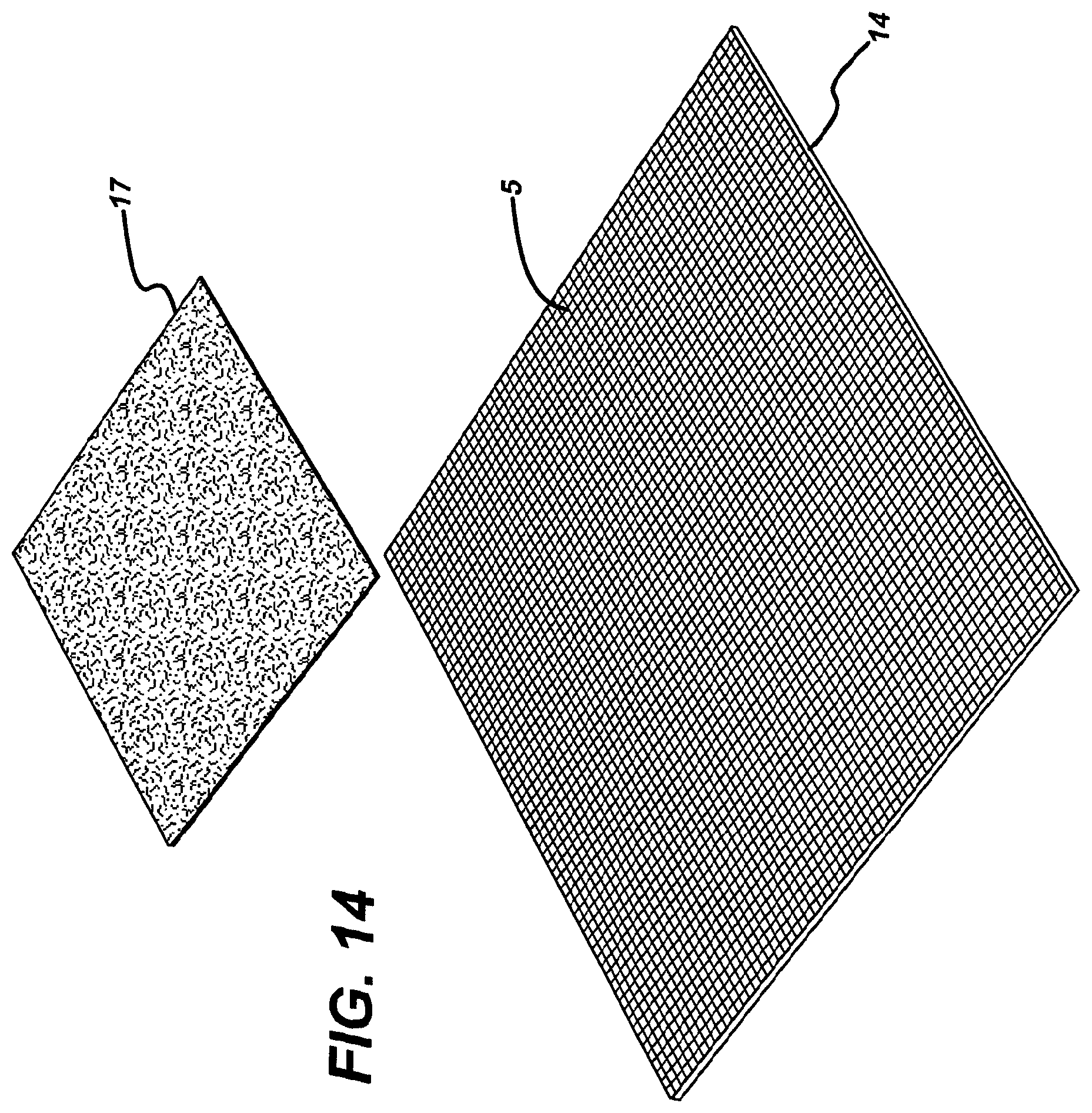
D00013
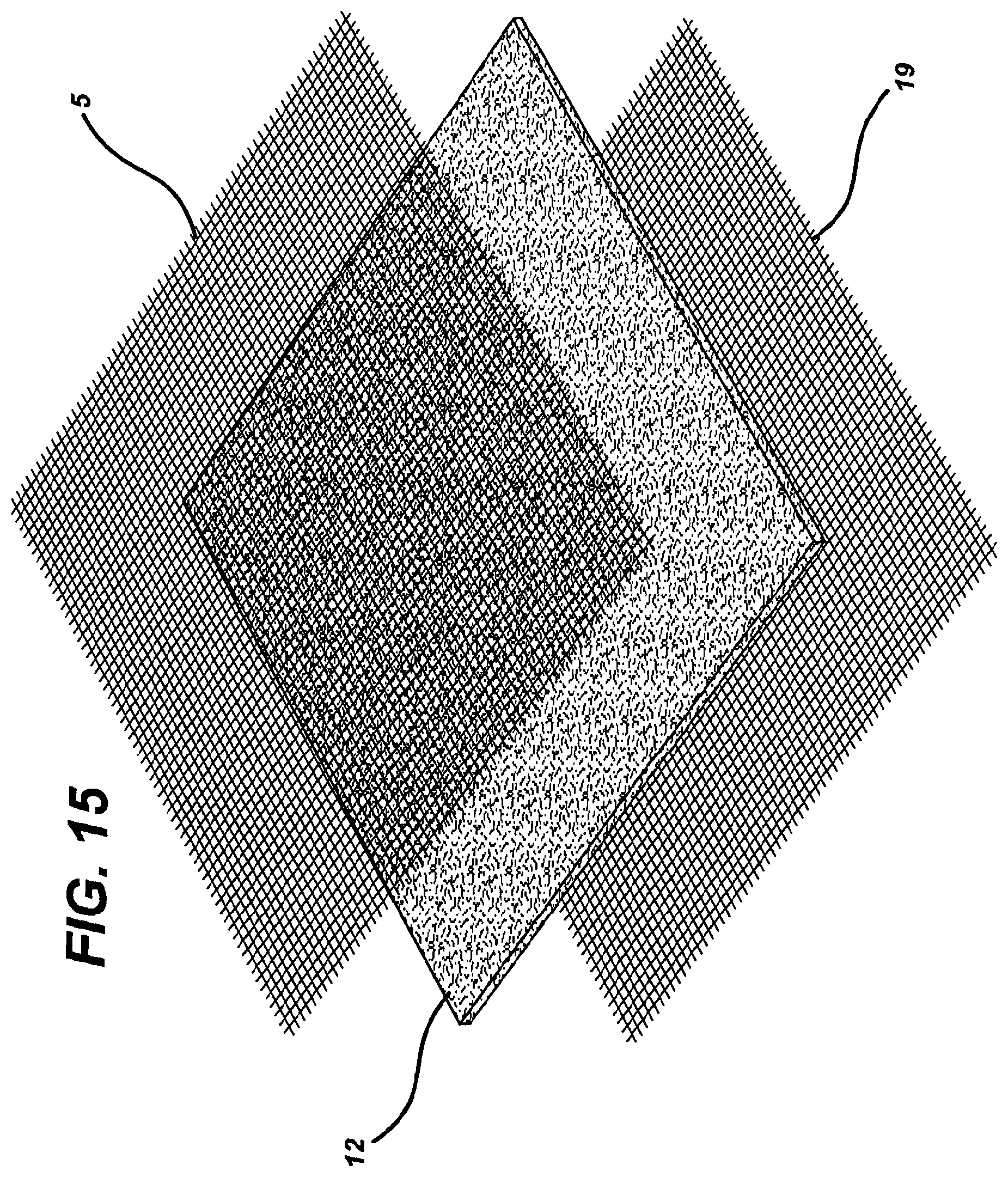
D00014
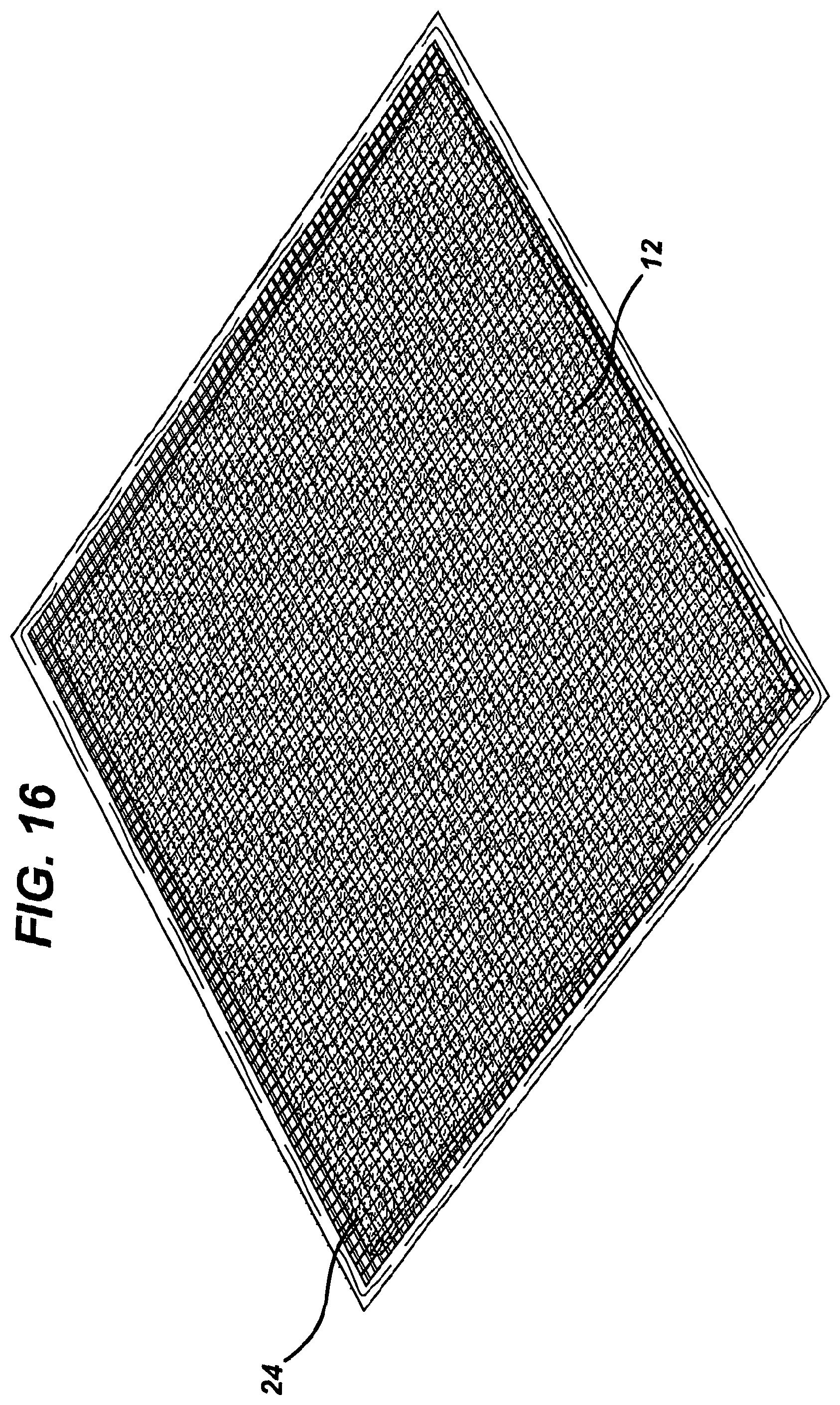
D00015
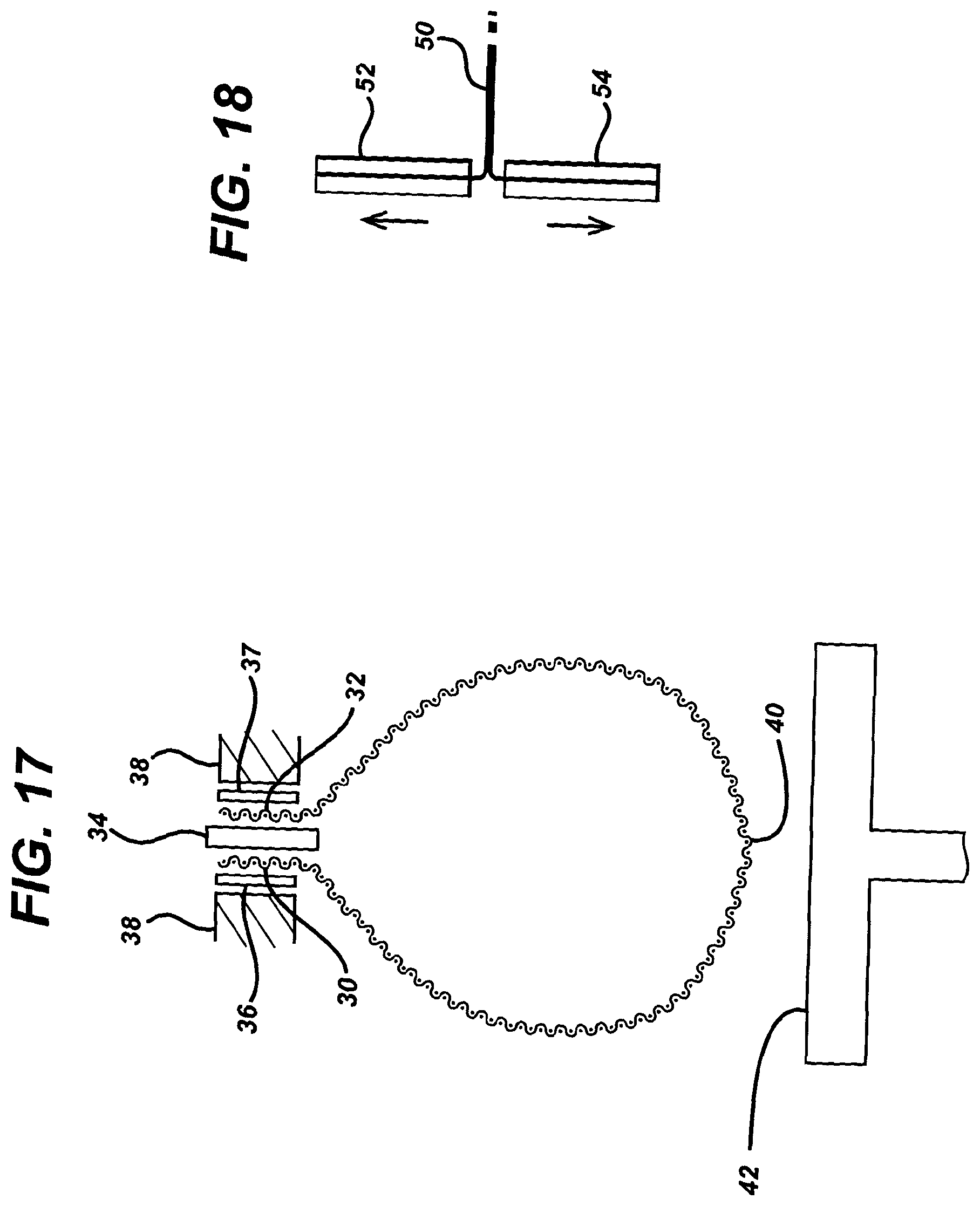
XML
uspto.report is an independent third-party trademark research tool that is not affiliated, endorsed, or sponsored by the United States Patent and Trademark Office (USPTO) or any other governmental organization. The information provided by uspto.report is based on publicly available data at the time of writing and is intended for informational purposes only.
While we strive to provide accurate and up-to-date information, we do not guarantee the accuracy, completeness, reliability, or suitability of the information displayed on this site. The use of this site is at your own risk. Any reliance you place on such information is therefore strictly at your own risk.
All official trademark data, including owner information, should be verified by visiting the official USPTO website at www.uspto.gov. This site is not intended to replace professional legal advice and should not be used as a substitute for consulting with a legal professional who is knowledgeable about trademark law.